
E-mail: font@focusonnature.com
Phone: Toll-free in USA 1-888-721-3555
or 302/529-1876
Website: www.focusonnature.com
 |
PO Box 9021,
Wilmington, DE 19809, USA E-mail: font@focusonnature.com Phone: Toll-free in USA 1-888-721-3555 or 302/529-1876 Website: www.focusonnature.com |
Rare and Threatened Birds
in
South America
in
the Andes and
Patagonia
including Argentina, Bolivia, Chile,
Colombia, Ecuador, Peru, Venezuela
Noting those found
during Focus On Nature Tours

Links:
Upcoming FONT
Birding & Nature Tours in:
Argentina Chile
Ecuador
FONT Past
Tour Highlights
Lists & Photo
Galleries of Birds of: Argentina
Chile Ecuador
More Rare Birds, in: the
Caribbean Brazil
Japan North &
Middle America
![]()
In the following list, places (states, provinces, or countries) where birds have been seen during FONT tours are noted.
SPECIES OF SOUTH AMERICAN BIRDS
IN THE ANDES & PATAGONIA
Species classified as CRITICALLY THREATENED:
Hooded Grebe
Junin Grebe Black-breasted
Puffleg Turquoise-throated Puffleg
Species classified as ENDANGERED:
Cauca Guan
Northern Royal Albatross Black-browed
Albatross Bogota Rail El Oro Parakeet
Violet-throated Metaltail Jocotoco
Antpitta Yellow Cardinal Pale-headed Brush Finch
Species classified as VULNERABLE:
Bearded Guan Dark-backed Wood Quail Black-fronted Wood Quail
Chubut Steamer Duck
Southern Rockhopper Penguin Wandering Albatross
Gray-headed Albatross Andean
Flamingo
Black-and-chestnut Eagle Austral Rail
Olrog's Gull Peruvian Pigeon
Golden-plumed Parakeet White-necked Parakeet
Spot-winged Parrotlet
Red-faced Parrot
Cloud Forest Pygmy Owl Little Woodstar Coppery-chested Jacamar Chestnut-bellied Cotinga
White-tailed Shrike Tyrant Cinnamon-breasted
Tody-Tyrant Giant Antpitta Moustached Antpitta
Rufous-necked
Foliage-gleaner Rufous-throated Dipper Cerulean Warbler
Masked
Mountain Tanager Tanager Finch
Tucuman
Mountain Finch
Species classified as NEAR-THREATENED:
Lesser
Rhea Wattled Guan Rufous-breasted Wood
Quail Ruddy-headed Goose Spectacled
Duck
Magellanic Penguin Sooty Shearwater
Red-legged
Cormorant Chilean Flamingo
Puna Flamingo Andean
Condor Striated Caracara
Semicollared Hawk Rufous-tailed Hawk
Horned
Coot Magellanic Plover Diademed
Plover Red Knot Hudsonian Godwit
Fuegian Snipe
Colombian Screech Owl Black-thighed
Puffleg Toucan Barbet
Plate-billed
Mountain-Toucan
Gray-breasted Mountain-Toucan Yellow-headed Manakin
Olive-sided
Flycatcher
Orange-banded Flycatcher Ochre-breasted Antpitta Peruvian Antpitta
Crescent-faced Antpitta
Maquis
Canastero Equatorial Graytail Star-chested Treerunner
Greater Scythebill Beautiful Jay
Bar-winged Wood Wren Golden-winged Warbler Gray-throated
Warbler Giant Conebill
Black-and-white Tanager Purplish-mantled
Tanager Masked Saltator
A New Species described recently,
in 2013: Pincoya Storm Petrel
![]()
Andean & Patagonian Bird
Species classified as CRITICALLY THREATENED
1 HOODED GREBE ______
in Patagonia: Argentina,
Chile
Podiceps gallardoi
The Hooded Grebe was discovered and described recently, in 1974. The discovery
was in Argentina about 150 kilometers east of the Perito Moreno Glacier (the Los
Glaciares National Park).
At first, only about 250 Hooded Grebes were thought to exist. During the next
two decades, a survey of the plateaus of Santa Cruz province was undertaken and
the estimated population of the Hooded Grebe was believed to be from 3,000 to
5,000 birds. Thus, in 1994, the status of the species was downlisted from
"threatened" to "near-threatened".
During its breeding season, the Hooded Grebe occurs solely on the high plateaus
in Argentinian Patagonia east of the Andes. It breeds on a few basaltic lakes in
the interior of Santa Cruz province.
In the winter, the species migrates. When the high plateau lakes are frozen,
most Hooded Grebes move to the Atlantic coast of Santa Cruz. The only known
wintering grounds are along the Santa Cruz, Coyle, and Gallegos estuaries.
The migratory flights of the Hooded Grebe across the Patagonian steppe are at
night.
The mystery of where the species went in the winter was not solved until 1994,
twenty years after the bird's discovery. To this day, the whereabouts of
immature birds during the harsh winter and their migration routes are still
unknown.
After the winter discoveries of 1994, it was assumed that the status
of the Hooded Grebe was secure, given the number thought to exist and the
remoteness of where the bird occurred.
But in 2009, a team of naturalists and biologists surveyed, during 3 weeks in
the summer, the known range of the Hooded Grebe, attempting to determine a
population count and find breeding colonies. And what they found was
disheartening, as many of the lakes were dry or becoming clogged with silt due
to the general desertification of the region.
The situation continued to be studied the next couple years, without good news.
During the years 2009 to 2011, strong winds caused around 50 per cent of all the
breeding attempts of the Hooded Grebe to fail.
The most recent counts at the wintering grounds indicated that during 7 years
there was a decline of the Hooded Grebe population by 40 per cent.
Surveys at known breeding sites in 2006 and 2007 also found sharp declines. At
one lake, where there had been 452 birds, there were 51. At 3 other lakes, where
collectively there had been nearly 1,000 birds, there were none.
In 2009, the species was uplisted from "near threatened" to
"threatened". Now the Hooded Grebe is listed as "critically
threatened", as the situation has continued to worsen.
During the last three breeding seasons (up to 2011), data has shown that the
estimated global population of the species fell close to 80 per cent, when
compared to what had been found back in the 1980s.
In the 1980s, an average of 2,500 Hooded Grebes were found at 78 lakes.
In 2011,
only 400 were found at those 78 lakes and at around 120 other lakes.
While it is thought that numbers can fluctuate considerably from year to year,
the overall declines that have been found at both the breeding and wintering
grounds of the Hooded Grebe sadly appear to be real and rapid.
The Hooded Grebe has been seen during FONT tours in far-southern Argentina,
in Patagonia. During one tour, as many as a hundred were nicely seen on one
lake.
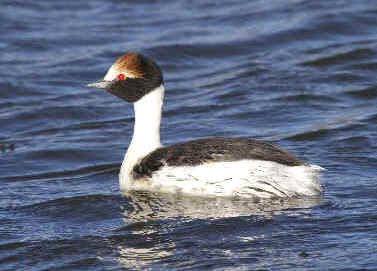
Hooded Grebe
2 JUNIN GREBE ______ in the Andes: Peru (where
endemic)
Podiceps taczanowskii
The Junin Grebe is not only endemic to Peru. It is
endemic to one particular Andean lake about 12.000 feet above sea level, Lake
Junin.
The bird has undergone a significant population decline.
In 1961, there were probably over 1,000 birds. In the 1980s, there
were about 250 birds.
Only 100 birds were counted in 1992, and the following year only 50 could
be found.
In 1995, up to just over 200 individuals were found to exist. But the
breeding seasons in 1995-1996 & 1996 & 1997 were unsuccessful.
Only 2 broods fledged in 1997-1998.
More recently, the population of the Junin Grebe was said to be just over
300 in 2001, about 250 in 2002, and just under 220 in 2007.
The Junin Grebe was seen during a tour in Peru organized by Armas Hill in
1980s, shortly before he created Focus On Nature Tours.

Junin Grebe
3 BLACK-BREASTED PUFFLEG
______ in the Andes: Ecuador (where
endemic)
Eriocnemis nigrivestis
The Black-breasted Puffleg was described
in 1852, from Tumbasco in Ecuador. At that time, it was seemingly
quite common as over 100 specimens went into museums.
More recently, the species was not seen from 1950 to 1980 when 3 were
found. It was not until 1993 that it was located with some regularity on
isolated forest ridges at Yanacocha on the slopes of Volcan Pichincha
near Quito. Apparently the bird is not a resident there as it is absent between
February and November, when it is believed to migrate to lower altitudes in
search of flowering food plants.
Charcoal production and slash-and-burn agriculture still threatens the very
small population of the Black-breasted Puffleg in its restricted range.
The Black-breasted Puffleg has been seen during FONT tours in Ecuador.
4 TURQUOISE-THROATED PUFFLEG ______
in the Andes: Ecuador (where
endemic)
Eriocnemis godini
Andean & Patagonian Bird Species classified as ENDANGERED:
5 CAUCA GUAN ______
in the Andes: Colombia (where
endemic)
Penelope
perspicax
6 NORTHERN
ROYAL ALBATROSS ______ in
Patagonia: Chile,
Argentina (offshore)
Diomedea sanfordi
The Northern Royal Albatross breeds on the
Chatham and Auckland Islands off New Zealand, on the South Island of New
Zealand.
Nearly all of the total population (99%) is on the Chatham Islands, where
there are from 6,500 to 7,000 pairs.
Thus, this species, classified as Endangered, is restricted to a tiny
breeding range, and the current decline equates to a rapid population reduction
of at least 55% in 60 years (3 generations).
Away from their breeding areas, both the Northern Royal Albatross (here)
and the Southern Royal Albatross (below, in the "Vulnerable
Species" section of this list) occur over oceanic waters off
the coasts of Patagonian South America.
Both species have been seen during FONT pelagic trips offshore from Chile.
7
BLACK-BROWED ALBATROSS
______ in Patagonia: Argentina,
Chile
Thalassarche melanophris
Nearly 75% of the world population
of the Black-browed Albatross breed on the Falkland Islands in the South
Atlantic Ocean.
The species also nests on South Georgia Island and on outer islands of southern
Chile: Diego Raimirez, Idlefonso, Evout and Diego de Almagro.
The Black-browed Albatross is now classified as endangered, as the species has undergone a
significant population
decline due at least in part to long-line fisheries.
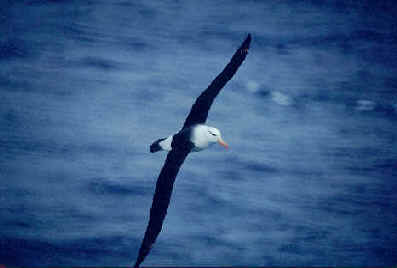
Above & below: Black-browed Albatrosses
photographed during FONT tours
(photo above by Alan Brady;
photos below by Bjorn Johansson))

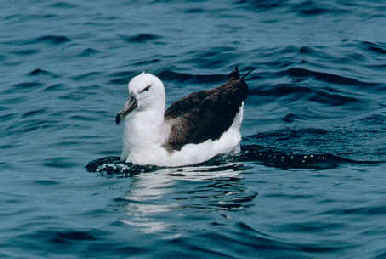
8 BOGOTA RAIL
______ in the Andes: Colombia (where
endemic)
Rallus semiplumbeus
9 EL
ORO PARAKEET ______
in the Andes: Ecuador (where endemic)
Pyrrhura orcesi
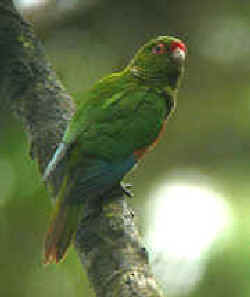
El Oro Parakeet
10 VIOLET-THROATED METALTAIL ______ in
the Andes: Ecuador (where endemic)
Metallura baroni
11 JOCOTOCO
ANTPITTA ______ in the Andes:
Ecuador, Peru (where
very rare)
Grallaria ridgelyi
The Jocotoco Antpitta was discovered on
November 20, 1997.
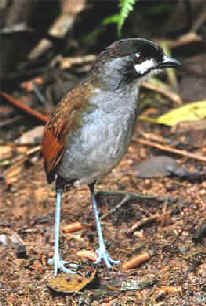
Above & below: the
Jocotoco Antpitta
Below, the handheld bird gives an idea of its size
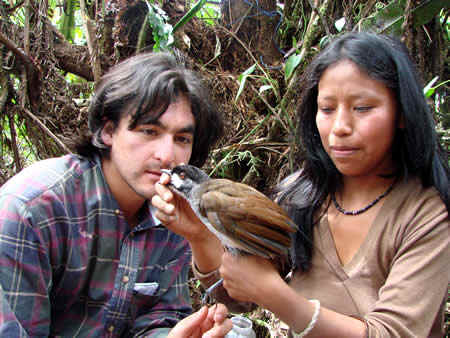
12
YELLOW
CARDINAL ______ in Patagonia:
Argentina, Uruguay
Gubernatrix cristata
The YELLOW CARDINAL is referred to in a
narrative later in this last, relating to the RED KNOT
(number #58 in the list).
The Yellow Cardinal has been seen during FONT tours in Argentina, in
northern Patagonia.
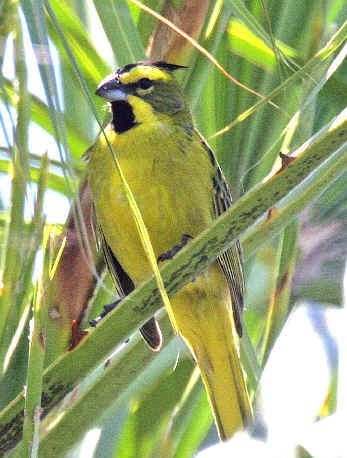
Yellow Cardinal
13 PALE-HEADED BRUSH FINCH
______ in the Andes: Ecuador (where
endemic)
Atlapetes pallidiceps
A slight recovery in the tiny population of the critically-threatened
Pale-headed Brush Finch has given some hope. As of 2010, it has increased
from less than 20 to 60 breeding pairs.
It is (in 2012) classified by Birdlife International as "endangered",
having been "critically endangered".
Threats to the species have been fires, grazing, competition with other brush
finches, and cowbird parasitism.
14 BEARDED GUAN ______ in the
Andes: Ecuador, Peru
Penelope barbata
15 DARK-BACKED WOOD QUAIL
______ in the Andes: Ecuador,
Colombia
Odontophorus melanonotus
The Dark-backed Wood Quail has been seen during FONT tours on the
western side of the Andes in Ecuador.
16 BLACK-FRONTED WOOD QUAIL ______ in
the Andes: Venezuela,
Colombia
Odontophorus atrifrons
17 CHUBUT (or WHITE-HEADED) STEAMER DUCK ______
in Patagonia: Argentina
(where endemic)
Tachyeres leucocephalus
The Chubut, or White-headed Steamer Duck has been seen during FONT tours in
southern Argentina, along the northern Patagonian coast of the South
Atlantic.
This is 1 of 3 flightless species in that area. The others are the Lesser Rhea
and Magellanic Penguin. All 3 of those species are in this listing of threatened
birds.
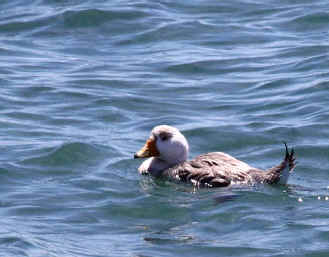
Above & below: Chubut, or
White-headed Steamer Ducks
during
the FONT tour in southern Argentina in December 2013
(photos by Marie
Gardner)
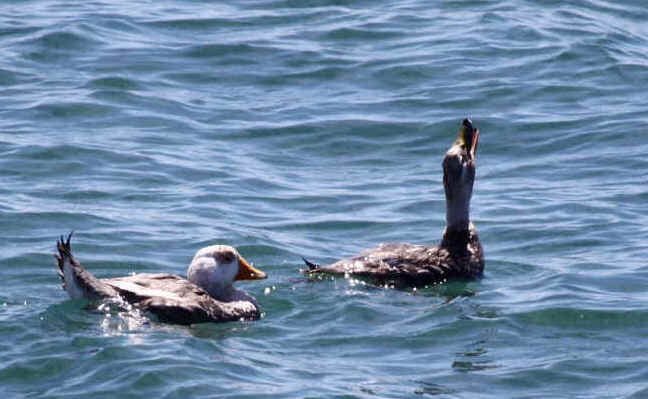
18 SOUTHERN ROCKHOPPER PENGUIN ______ in
Patagonia: Argentina
Eudyptes Chrysocome
Some taxonomists consider all of the populations of
Rockhopper Penguins to be one species with 3 subspecies.
However, others assert that those around the southern coasts of South America
and in the subarctic waters of the southern Pacific Oceans are the Southern
Rockhopper Penguin, Eudyptes chrysocome.
What is called the Northern Rockhopper Penguin, Eudyptes
moseleyi, lives in waters separated by the Subtropical Front, and is
genetically different.
It breeds on Tristan de Cunha, Gough, St. Paul, and Amsterdam Islands in South
Atlantic & Indian Oceans.
The Southern Rockhopper Penguin has been seen during FONT Argentina tours in
Patagonia in the area of Puerto Deseado.
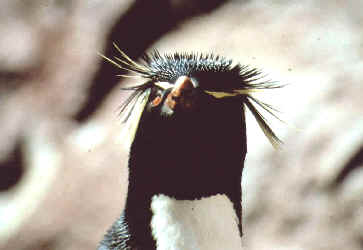
A
Southern Rockhopper Penguin photographed
during a FONT tour in Argentina
(photo by Alan
Brady)
19 WANDERING ALBATROSS
______ in Patagonia: Chile, Argentina
(offshore)
Diomedea exulans
The Wandering Albatross and the Royal Albatrosses
(the Northern & the Southern, both in this list)
has wingspans as long as 330 centimeters or 130 inches, that is nearly 11 feet
across and a length of over 5 feet per wing. These are the longest wings in
nature.
THE FOLLOWING IS FROM THE FINE BOOK, "EYE
OF THE ALBATROSS"
written by Carl Safina, published in 2002:
Albatrosses are creatures
of air inside and out. Air sacs surround their organs and extend even
into their hollow wing bones.
An albatross's entire skeleton accounts for only 15 per cent of the
bird's total weight.
One would expect massive flight muscles, but again these birds can surprise one.
In most birds, flight muscle accounts for about 16 per cent of body
weight, but most albatrosses' flight muscles amount to only 9 per cent of body
mass.
In the great Wandering and Royal Albatrosses, flight muscle is a
mere 6 per cent, with very reduced biceps.
These creatures are truly gliding machines.
More than anything, albatrosses' long narrow wings make them extreme
range mileage mechanisms. The ratio of wingspan to wing width of a
Wandering Albatross is 18 to 1, similar to the best human-made gliders.
For the Wandering Albatross, the wings' lift-to-drag ratio,
that is lifting force to air resistance, is a remarkable 40 to 1, more
than triple that of many eagles.
Although so adept at mining energy from the weather, the gigantic
Wandering and Royal Albatrosses are really "gliding-adapted"
to a fault, They are incapable of sustained flapping flight. Calm weather leaves
them stranded on the sea surface.
Their existence depends on having winds that continue blowing. Fortunately for
them, where they live in the Southern Hemisphere, wind remains plentiful, at
least for now.
Indeed, the large albatrosses as we know them could only have evolved in
the windiest place on Earth - the Southern Oceans, where an abundant
supply of moving air has breathed creation into Life's most amazing capacity
for flight.
Both the Wandering Albatross (here) and the
Southern Royal Albatross (below) occur over oceanic waters off
the coast of Patagonian South America.
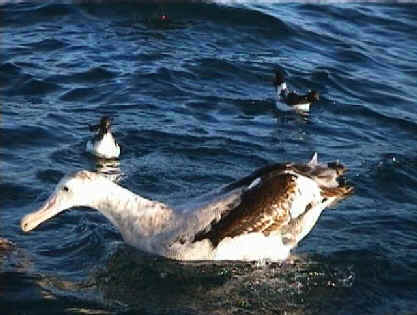
A Wandering Albatross during a
FONT tour.
Dwarfed by it are two Cape Petrels.
(photo by Steve Gantlett)
20 SOUTHERN ROYAL ALBATROSS ______ in
Patagonia: Chile,
Argentina (offshore)
Diomedea epomophora
The Southern Royal Albatross breeds on
Campbell and Auckland Islands off New Zealand. Global population about
28,000 individuals. The main threat to the species is offshore long-line fishing
activity.
The Southern Royal Albatross has been seen
during FONT pelagic trips offshore from Chile.
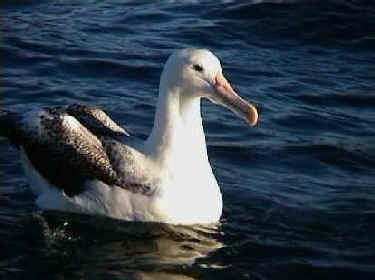
A Southern Royal Albatross
photographed
during a FONT pelagic trip off the coast of Chile.
21
GRAY-HEADED ALBATROSS ______
in Patagonia: Chile, Argentina
Thalassarche chrysostoma
About half of the world population of the
Gray-headed Albatross breeds on South Georgia Island in the South
Atlantic Ocean, but also nests on outer islands of southern Chile: Diego
Ramirez and Idlefonso.
It disperses in the South Atlantic north to 35 degrees S and in the Pacific, in
the Humboldt Current, north to 15 degrees S off Peru.
The Gray-headed Albatross is classified as Vulnerable, with a
declining global population estimated at about 250,000 individuals. There is
believed to have been a 20% decrease over the last 60 years (3 generations). A
high mortality-rate is associated with long-line fishing.
The Gray-headed Albatross has been seen during FONT pelagic trips
offshore from Chile.
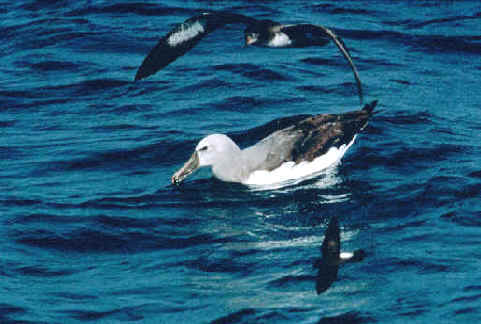
A Gray-headed Albatross
photographed during a FONT tour in Chile.
Also in the photo are a Pink-footed Shearwater (above)
and a Wilson's Storm Petrel (below).
Like the albatross, the Pink-footed Shearwater is classified
by Birdlife International as a "vulnerable species".
(photo by Harold Lebo)
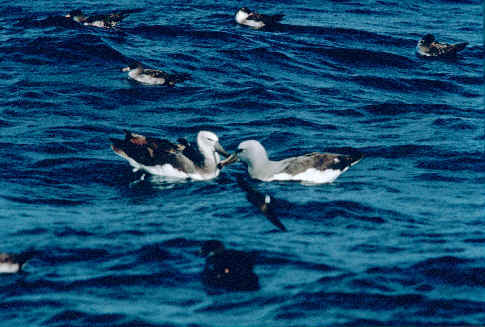
Two albatrosses during a FONT
pelagic trip off the coast of Chile.
The bird on the right, a Gray-headed Albatross.
The bird on the left, a Black-browed Albatross, a species
elsewhere in this list, in the grouping of birds classified as
"endangered".
When this photograph was taken, in the early 1990s,
the Black-browed Albatross was not yet considered threatened,
or even near-threatened.
(photo by Harold Lebo)
22 ANDEAN
FLAMINGO ______ in the Andes:
Argentina, Chile
Phoenicopterus andinus
23 BLACK-AND-CHESTNUT EAGLE ______ in
the Andes: Ecuador
Oroaetus isidori
24 AUSTRAL RAIL ______
in Patagonia: Argentina, Chile
Rallus antarctius
Until 1998, there were only 3 records of the Austral Rail
since 1900, and none since 1959.
In January 1998, an effort was made to find the bird, and it was found
(in response to a tape recording of the similar Virginia Rail)
between Calafate and La Angostura, in the Santa Cruz province of Argentina. An
individual of this obviously secretive species, responding to the taped call,
gave a sufficiently good view to substantiate the rediscovery of the species.
Since then, the Austral Rail has been found at a number of sites in that
part of Argentina, and even in Chile.
In Argentina, the sites have been at 7 localities in Santa Cruz
province and 2 in Chubut.
In Chile, two sites for the Austral Rail have been in Magallanes.
So it was in 1998 that the voice of the Austral Rail, itself, was
determined. The bird gives a series of 5 to 10 high-pitched and strident
"pi-ric" notes introduced by a single "pic". Also the bird
has a loud call.
Curiously, all of the recent records of the Austral Rail have been
outside the historical range, despite searchings at former haunts.
That the bird is found in Patagonia during its breeding season,
while the historical Buenos Aires specimens were taken in the autumn and winter,
seems to confirm that the species is migratory. On the other hand, there
were old breeding records in central Chile (well to the north of Patagonia).
A recent record of an Austral Rail on the Falkland Islands seems
to have been a vagrant, thus substantiating the species to be migratory.
The Austral Rail has a dusky red bill, and pinkish-red legs.
A common bird also in Patagonia, the Plumbeous Rail, is larger than
the rare Austral Rail.
The Plumbeous Rail, Pardirallus sanguinolentus,
has a green bill (longer than that of the Austral Rail), and plain
underparts and an unbarred rear.
All of the crakes in Argentina are smaller than the Plumbeous Rail
and the Austral Rail.
An Austral Rail was seen during the FONT Argentina Tour in December 2013
at a marsh in Patagonia in the province of Santa Cruz, northwest of La
Leona.
It was seen as it did a quick, short flight, dropping into the reeds of the
marsh.
25 OLROG'S
GULL ______ in Patagonia: Argentina
Larus atlanticus
The Olrog's Gull has been seen during FONT tours in Argentina along
the Patagonian seacoast of the South Atlantic.
26 PERUVIAN (or MARANON) PIGEON ______
in the Andes: Ecuador, Peru
Patagioenas oenops
27 GOLDEN-PLUMED
PARAKEET ______ in
the Andes: Ecuador
Leptosittaca branickii
28 WHITE-NECKED PARAKEET ______ in
the Andes: Ecuador
Pyrrhura albipectus
29 SPOT-WINGED PARROTLET ______ in
the Andes: Ecuador
Touit stictoptera
30 RED-FACED PARROT ______
in the Andes: Ecuador
Hapalopsittaca pyrrhops
31 CLOUD FOREST PYGMY OWL ______ in
the Andes: Ecuador,
Colombia, possibly Peru
Glaucidium nubicola
32 LITTLE
WOODSTAR ______ in the Andes:
Ecuador
Acestrura bombus
During a FONT tour in Ecuador in July 1997, a nest was found of the Little
Woodstar.
A Little Woodstar was also seen during the FONT Ecuador Tour in April
2013.
The Little Woodstar is close to being the smallest bird in the
world, from 2.36 to 2.75 inches in length.
The nest of the Little Woodstar is little too: 1.35 inches high, with a
depth in the cup of 0.66 inches, and an interior diameter of 0.65 inches.
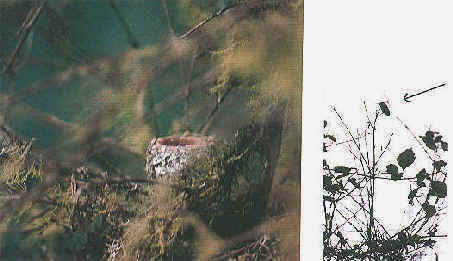
A nest of
the Little Woodstar (left photo); the bird (in right photo, indicated
by an arrow) smaller than the leaves.
During a FONT tour in western Ecuador in July 1997.
The Little Woodstar, a species not commonly seen, is one of the smallest of all
hummingbirds.
33 COPPERY-CHESTED JACAMAR ______
in the Andes: Ecuador
Galbula pastazae
34 CHESTNUT-BELLIED COTINGA
______ in the Andes: Ecuador,
Colombia
Doliornis remseni
35 WHITE-TAILED SHRIKE-TYRANT ______
in the Andes: Chile, Ecuador
Agriornis andicola
The White-tailed Shrike-Tyrant was seen nicely during the FONT Ecuador Tour
in April 2013, in the High Andes not far from where we enjoyed watching Andean
Condors.
36 CINNAMON-BREASTED TODY-TYRANT
______ in the Andes: Ecuador
Hemitriccus cinnamomeipectus
37 GIANT ANTPITTA ______ in
the Andes: Ecuador
Grallaria gigantea
38 MOUSTACHED ANTPITTA ______ in
the Andes: Ecuador
Grallaria alleni
The Moustached Antpitta has been seen during FONT tours on the
western side of the Andes in Ecuador.
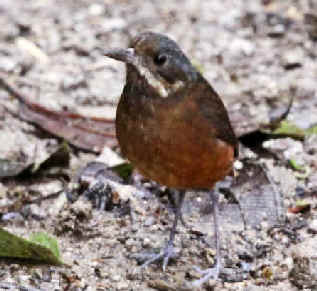
A Moustached Antpitta photographed
during the FONT Ecuador Tour in April 2013
(photo by Marie Gardner)
39 RUFOUS-NECKED FOLIAGE-GLEANER ______
in the Andes: Ecuador
Syndactyla ruficollis
40 RUFOUS-THROATED
DIPPER ______ in the Andes:
Argentina
Cinclus schulzi
The Rufous-throated Dipper has been seen during FONT tours in northwestern
Argentina.
41 CERULEAN WARBLER ______
in the Andes: Venezuela, Ecuador
Setophaga (formerly Dendroica) cerulea
THE FOLLOWING IS FROM THE
"BIRDLINE" by Armas Hill on November 8, 2011:
There's a rather new book about the Cerulean Warbler entitled "Cerulean
Blues: A Personal Search for a Vanishing Songbird", written by
Katie Falon.
"Cerulean Blues" describes the plight of the Cerulean
Warbler as it struggles to survive in ever-shrinking suitable habitat.
It is now said to be the fastest declining warbler species in the United
States, with 3 per cent of its total population lost each year since 1966.
That means that there are now 80 per cent fewer Cerulean Warblers that
there were 40 years ago, and their numbers continue to drop, due to factors such
including deforestation.
In South America, the Cerulean Warbler occurs, when it is
winter in the Northern Hemisphere, in Venezuela and Colombia, and
as far south as eastern Ecuador, southeastern Peru, and perhaps
occasionally in northern Bolivia.
"Wintering" birds are found in Andean submontane forest, mainly
between 1,000 and 2,000 meters above sea level.
Dead birds have been found in the paramo habitat at 3,550 meters (about 10,650
feet) above sea level in the Venezuelan Andes around Laguna de Mucubaji
near Merida.
42 MASKED MOUNTAIN TANAGER ______
in the Andes: Ecuador
Buthraupis wetmorei
43 TANAGER FINCH ______ in the
Andes: Ecuador
Oreothraupis arremonops
The rare Tanager Finch was seen early one morning during the FONT Ecuador
tour in April 2013 on the western side of the Andes. 3 individuals were
seen

The rarely-seen Tanager
Finch
photographed during the FONT tour
in Ecuador in April 2013
(photo by Marie Gardner)
44 TUCUMAN MOUNTAIN FINCH ______
in the Andes: Argentina (where
endemic)
Poospiza baeri
The Tucuman Mountain Finch has been found during FONT tours in northwestern Argentina.
Andean & Patagonian Bird Species classified as NEAR-THREATENED:
45 LESSER RHEA
______ in Patagonia: Argentina, Chile
Rhea pennata
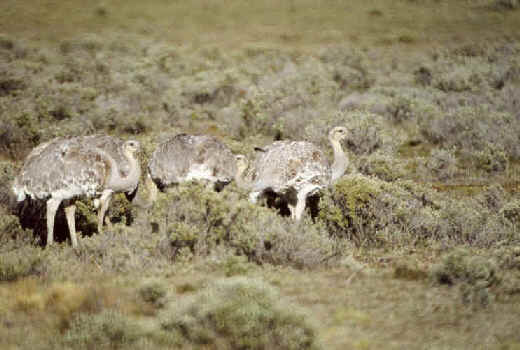
Above & below: Lesser Rheas photographed
during FONTs tour in Patagonia
This subspecies, Rhea p. pennata, is called the "Darwin's Rhea".
Below: about 50 of them on a road on the Valdes Peninsula
during the FONT tour in southern Argentina in December 2013.
To the right, in the photo,
a lone adult bird, a male raising multiple broods,
of various ages, with some of the young larger and some smaller.
Quite a sight in front us on the road.
(upper photo by
Alan Brady in far-southern Chile;
lower photo by Marie Gardner in southern Argentina.)
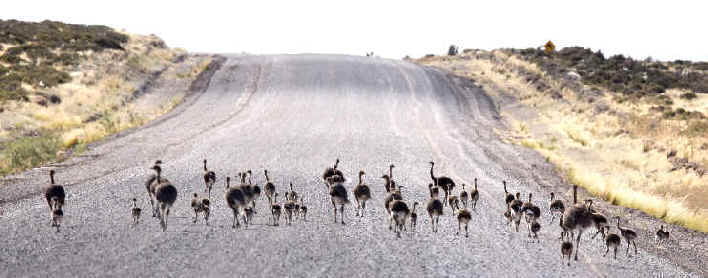
46 WATTLED GUAN ______
in the Andes: Ecuador
Aburria aburri
47 RUFOUS-BREASTED WOOD QUAIL ______ in
the Andes: Ecuador
Odontophorus speciosus
The Rufous-breasted Wood Quail was seen nicely during the FONT
Ecuador Tour in April 2013.
48 RUDDY-HEADED GOOSE ______ in
Patagonia: Argentina,
Chile
Chloephaga rubidiceps
The Ruddy-headed Goose haws been seen during FONT tours in Patagonian Argentina
and Chile.
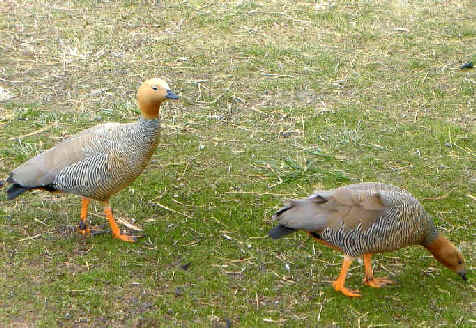
Ruddy-headed Geese
(photo by Hubert Hall)
49 SPECTACLED (or
BRONZE-WINGED) DUCK ______ in the
Patagonian Andes: Argentina,
Chile
Anas specularis
The Spectacled Duck was seen during our FONT tour in far-southern Argentina
in December 2013.
Two photographs are below of a single bird at the Perito Moreno Glacier.
That same day, elsewhere in that area, a family of Spectacled Ducks was seen,
with the 2 adults and ducklings.
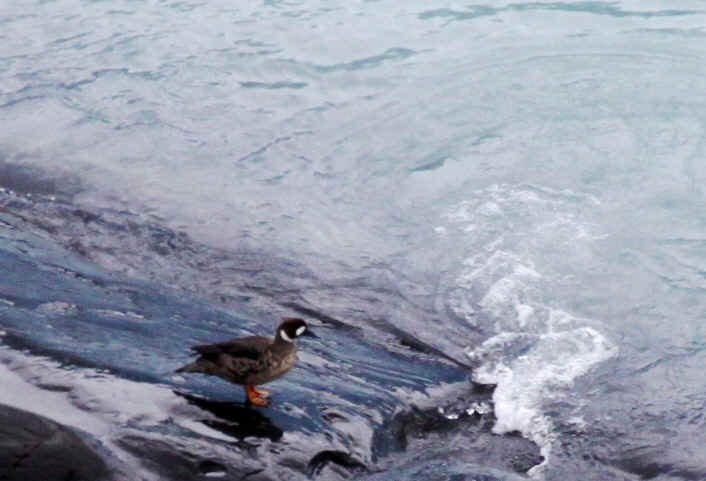
This Spectacled Duck seemed to
like the cold water by the glacier.
In the photo below, it is swimming among large pieces of ice.
(photos by Marie Gardner)
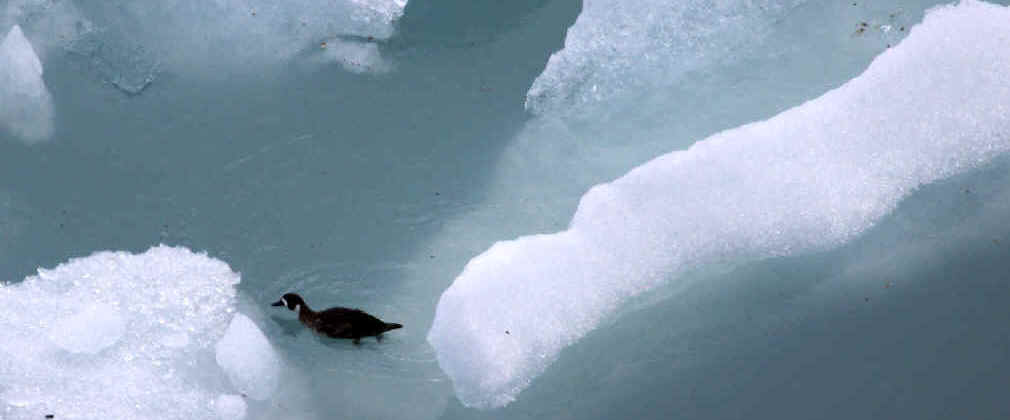
50 MAGELLANIC
PENGUIN ______ in Patagonia:
Argentina,
Chile
Spheniscus magellanicus
During recent years, the total population of the Magellanic Penguin has
been decreasing.
As of 2012, that population has been estimated as being 1.3 million
pairs, with 950,000 breeding along the coast of Argentina, at
least 100,000 in the Falkland (Malvinas) Islands, and at least
200,000 nesting in Chile.
In Argentina, there are just over 60 sites where Magellanic Penguins
breed.
In Chile, there are at least 10 locations.
Recent population trends have been different at various colonies. The two
largest colonies in Argentina have had decreases during the last decade,
but other smaller colonies have grown.
In Argentina, the Caleta Valdes colony has increased from 2 pairs in the
early 1960s to 26,000 pairs in the early 1990s.
The Isla Deseado colony, in Argentina, more than doubled between 1986
and 1996.
What has been a very large colony in Argentina at Punta Tombo has
decreased by about 30 per cent since 1987, with high juvenile and young adult
mortality.
The Cabo Virgenes colony has remained stable for the last 10 years.
In Argentina, Magellanic Penguins have been seen during FONT tours at
a number of the nesting colonies just mentioned, including Punta Tombo, Isla
Deseado, and Caleta Valdes, and also in far-southern Argentina in the area of
the Beagle Channel and elsewhere around Tierra del
Fuego.
In Chile, Magellanic Penguins have been seen during FONT tours at various places
including sites on Chiloe Island, near Vina del Mar, and near Punta Arenas.
Outside their breeding season, Magellanic Penguins migrate north to the coast
and offshore waters of Brazil. During FONT tours in that country, they have been
seen in Rio Grande do Sul and near Ubatuba in Sao Paulo state.
Magellanic Penguins,
tracked by satellite and GPS sensor tags during their breeding season, have been
found to typically forage more than 100 kilometers from their nesting sites, and
sometimes, at various colonies in Argentina, as much 600 kilometers from
the sites.
Individual Magellanic Penguins show a high site fidelity, with nearly all
birds returning to the colony in which they were born, and with most adults
using the same burrow year after year.
As vagrants, Magellanic Penguins have occurred as far north (in the
Pacific Ocean) as El Salvador in 2007, and south to Avian Island on the Antarctic
Peninsula, and also as far away as New Zealand and Australia.
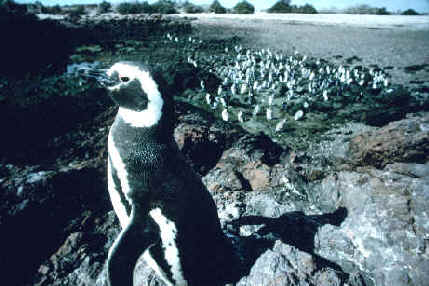
Above: Magellanic Penguins
at the colony in Argentina at Punta Tombo
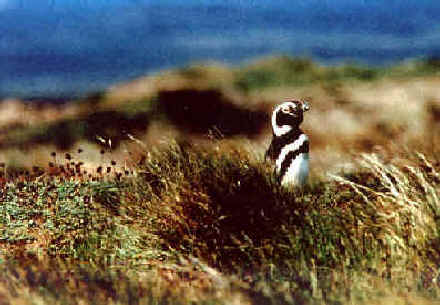
Above &
below: Magellanic
Penguins
during FONT tours in Chile.
Above, near Punta Arenas. Below. on Chiloe Island.
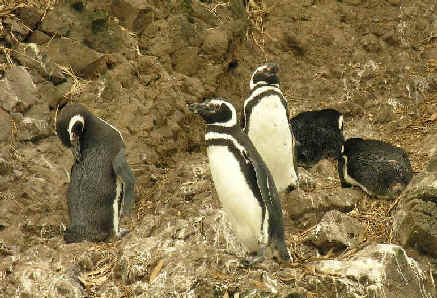
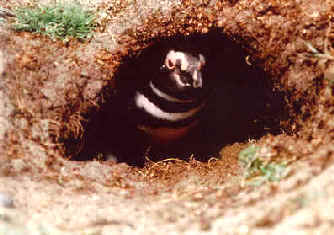
And lastly, a Magellanic Penguin
peering from its burrow in Argentina.
Photographed during a FONT tour.
51 SOOTY SHEARWATER ______
in Patagonia: Chile,
Argentina
Puffinus griseus
The Sooty Shearwater has been a common
austral summer resident to offshore far-southern South American waters.
It has bred in large numbers during September-May in far-southern Chile
in the Diego Ramirez Islands and the Wollaston Archipelago (Cape Horn) and also
at the Magellanes, Guamblin (Aysen), and Guafo Islands, and Chiloe Island.
After the breeding season, it disperses northward to the coastal waters of the
North Pacific Ocean.
The Sooty Shearwater is highly gregarious, congregating in huge and
extensive flocks. During migration, it has been in flocks of up to hundreds of
thousands of birds.
Although the Sooty Shearwater has had a very large global population,
it is said by Birdlife International to have undergone a moderately rapid
decline due, to among other reasons, the impact of fisheries. Thus, it is now
classified as a globally "near-threatened" species.
During FONT tours in southern South America, the Sooty Shearwater has been
seen either offshore or from shore.
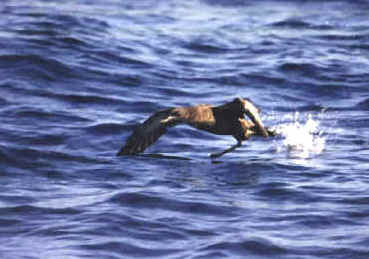
A Sooty Shearwater
photographed during a FONT pelagic trip.
The species has been seen during FONT pelagic trips
in the North Atlantic Ocean off eastern North America.
in the South Pacific Ocean off western South America,
and in the North Pacific Ocean off western North America,
Costa Rica, and Japan.
Only very few other species have been seen
during FONT pelagic trips at so many places.
52 RED-LEGGED
CORMORANT ______ in
Patagonia: Argentina,
Chile
Phalacrocorax gaimardi

Red-legged Cormorant
53 CHILEAN FLAMINGO ______ in the
Andes & Patagonia: Argentina,
Chile
Phoenicopterus chilensis
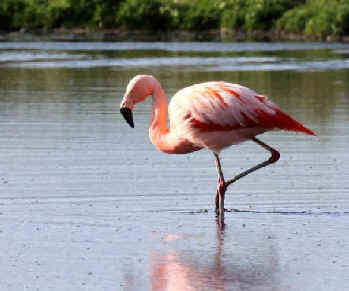
Above & below: Chilean
Flamingos photographed during
the FONT tour in southern Argentina in December 2013
Above: an adult Below: immatures
(photos by Marie
Gardner)
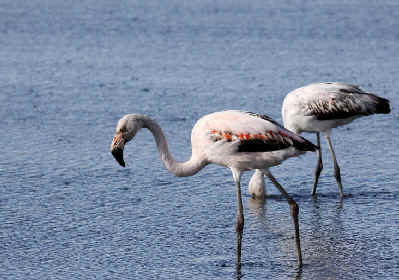
54 PUNA (or JAMES') FLAMINGO ______
in the Andes: Argentina, Chile
Phoenicopterus jamesi
55 ANDEAN CONDOR
______ in the Andes & Patagonia:
Argentina, Chile, Ecuador
Vultur gryphus
From the book, "THE FLIGHT OF THE CONDOR" by
Michael Andrews, published in 1982,
which was a companion to the television series with the same name by the BBC,
and on PBS in the U.S.,
the following excerpts relate to the ANDEAN CONDOR:
"Anyone who has once seen an Andean Condor in flight is unlikely to
confuse it with anything else. The broad straight wings with their spreading
"fingers", the heavy wedge of a tail and the short neck
all add up to a characteristic silhouette.
Its wing area is near 2 square meters (or 4.6 square feet), a with the weight
of about 12 kilos (26.4 pounds), this gives it the low wing-loading necessary
for slow soaring flight.
One can watch an Andean Condor fly for hours without seeing it flap, and
then it is usually only to takeoff, or a few strokes before gliding again."
Andrews wrote that during his days with the filming of "The Flight of
the Condor", he "only saw once a group of condors flapping
hard, and that was as they raced downward across the Peruvian Andes ahead of a
storm."
"In the air the bird moves with such skill and grace that one forgets how
cumbersome it is on the ground. It is also hard to get an accurate impression of
its size"
"The first time"", Andrews wrote, that he "realized just how
big a condor is" was when he saw "a stuffed one perched on the
grand piano of the Director of the Chilean Academy of Music. It dwarfed the
instrument."
Andean Condors are birds of the vast solitudes of the mountains, shying
away from areas frequented by man. There are a few in Colombia, but
they are mostly to be found from Ecuador south to Cape Horn. They do not
fly north of the Rio Negro on the coastal plains of Argentina (the river
that forms the northern boundary of Patagonia), nor do they fly to the coast in Ecuador
or Colombia. But they do frequent the desert coast of Peru in the
summer.
Individual Andean Condors have been kept in captivity for over 50
years, and their natural life-span is also long.
The young do not acquire their full breeding plumage, with a white neck
ring and a large patch of white on the upper surface of the wings, until they
are 8 years old. Before that, they are brown.
The young birds fly with the adults for several years after they have
fledged, and they observe a pecking order when feeding together on the
ground, with that order established by their making a nibbling beak to beak
action.
It seems that Andean Condors find their prey by keen eyesight,
watching each other, as well as the ground, as they cruise in wide circles over
the mountains.
When one condor sees carrion, or the activities of Caracaras
or Turkey Vultures, it descends, and others soon follow it down.
Apparently, Andean Condors has little sense of
smell. In that regard, Charles Darwin conducted some basic experiments,
carrying a piece of meat wrapped in white paper past a row of tethered condors
at a distance of 3 yards.
He wrote:
"No notice whatsoever was taken. I then threw it on the ground within one
yard of an old male bird. He looked at it for a moment with attention, but then
regarded it no more. With a stick I pushed it closer and closer, until at last
he touched it with his beak. The paper was then instantly ripped off with fury,
and at the same moment every bird in the long row began struggling and flapping
its wings."
Since Darwin's day, there have been many more scientific experiments relating to
birds' sense of smell, and it is now known that Turkey Vultures and Yellow-headed
Vultures can smell.
There seems little doubt that the Andean Condor exploits the Turkey
Vulture's abilities when it can.
Andean Condors have figured in the mythology of the native
people of South America for thousands of years.
There is an unmistakable outline of one drawn on the famous pampa of the Nazca
line, and their image appears on the pottery and textiles of many of the early
pre-Inca cultures.
The depiction of an Andean Condor is on the coat-of-arms of four
of the South American republics, and Bolivia's highest order of merit is the Order
of the Condor.
With that, it probably is best not to think too much of the fact that the Andean
Condor is a "large vulture".
During the April 2013 FONT tour in Ecuador, as many as 21 Andean Condors were
seen at one time.
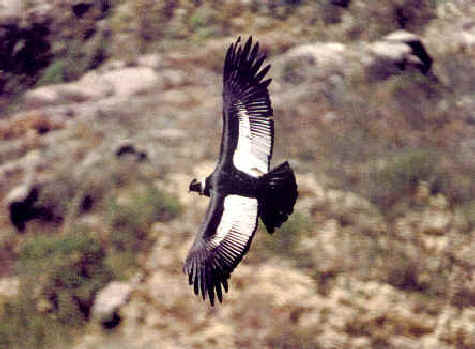
Andean Condor
56 STRIATED CARACARA ______
in Patagonia: Argentina, Chile
Phalcoboenus australis
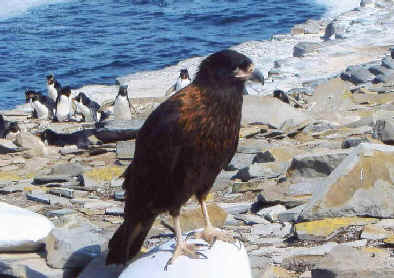
Striated Caracara
(photo by Hubert Hall)
57 SEMICOLLARED
HAWK ______ in the Andes: Ecuador
Accipiter collaris
58 RUFOUS-TAILED HAWK ______ in
Patagonia: Chile
Buteo ventralis
59 HORNED COOT ______ in
the Andes: Argentina,
Chile
Fulica cornuta
60 MAGELLANIC PLOVER ______ in
Patagonia: Argentina,
Chile
Pluvianellus socialis
Magellanic Plovers (3 of them) were seen during the FONT tour
in Patagonian Argentina in December 2013.
Two of them are in lower photo below.
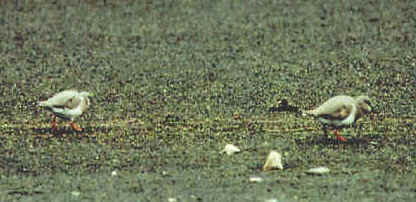
Above & below: pairs
of rare Magellanic Plovers photographed
during FONT tours in far-southern Patagonia.
Those below were during the our Argentina Tour in December 2013.
(lower photo by
Marie Gardner)
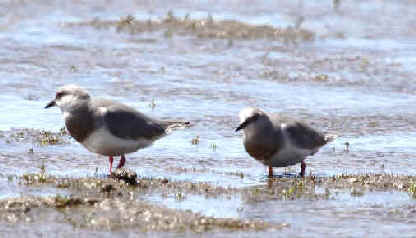
61 DIADEMED PLOVER ______ in
the Andes: Chile,
Peru
Phegornis mitchellii
Phegornis mitchellii
has also been called the Diademed Sandpiper-Plover. Another old name for
it was the Mitchell's
Plover.
By whatever name, Phegornis mitchellii
is a most unusual bird, and one that's truly special.
Where it occurs in the High Andes, in the puna zone, from Peru and Bolivia
south
to central Chile and Argentina, the Diademed Plover is local in
distribution.
In addition to being rare, the little 7 inch-long bird can often be difficult to
find as it is inconspicuous due to its small size, confiding nature, slow movements, and a rather
effective camouflage.
As to even its basic ecology, still
much is unknown about the Diademed Plover. Older books refer to the bird's seasonal movements and
other aspects of its behavior as "unknown", and still today such
information is lacking, primarily due to the remote, and often inaccessible
places where it occurs.
With its sandpiper-like bill, there has over the years, been some uncertainty as
to the taxonomic position of Phegornis mitchellii.
What is now called the Diademed Plover was first described in 1845.
In 1888, there was still some question about it, as it was placed among the
Scolopacidae, the sandpiper family, with the name of Chilean Short-winged
Sandpiper.
In the 1920s, it was said to have greater affinities with the plovers, and it
was included among them in the Charadriidae.
As late as in 1958, in a comprehensive review of the world's plovers, it was
concluded that there was insufficient evidence to either retain Phegornis
mitchellii among the plovers or to place it with the
sandpipers and that consequently its true affinities were "still
unknown". Thus, the name Diademed Sandpiper-Plover.
Since then, taxonomists have decided to put
Phegornis mitchelli with the plovers, and thus now the shortened
common name.
The adjective in the name Diademed Plover relates to the striking white
ring that adorns the bird's dark head.
The Diademed Plover is a remarkable denizen of the high Andes. In the
northern part of its range (in Peru) lives at an altitude of from 10,000 to
16,000 feet above sea level.
At a well-known site for the bird in the southern part of its range, in the
Andes of central Chile, it occurs during its breeding season at about 8,000
feet above sea level. In that southern part of its range, the bird is a
migratory species, arriving in its nesting area in October.
In the southern part of its range, the Diademed Plover may occur as low
as 6,000 feet above sea level, but in the north it is not ever found below an
altitude of 10,000 feet.
There may be a limited northward migration along the Andes after the bird's
nesting season, but, as noted earlier in this narrative, even yet seasonal
movements of the Diademed Plover, when not breeding, remain uncharted.
Some sightings have suggested that they may be, that time of year, in high
Andean passes, and if so, they would be enduring weather and elements not
experienced by any other shorebird.
The population of the Diademed Plover is said to be small and
seemingly declining. Birdlife International estimates the total
population throughout its rather large range as being less
than 10,000 individuals, with mature birds rounded off to being from about 1,500 to
maybe, at best, 7,000. These birds are in a number of subpopulations throughout the species'
range.
At the site referred to here earlier, at 8,000 feet above sea level in central
Chile, the Diademed Plover has been seen during more than a dozen tours since
1990.
That site, in a valley nestled among snow-capped peaks, is with montane
streambeds and bogs. Diademed Plovers favor such places by shallow
streambeds and high-elevation bogs, where they can be found on the ground among
the cushion plants.
The birds, with their unplover-like, peculiar long bills, frequently
pause atop cushion plants, or rocks, and then they suddenly begin dipping their
bodies forward every few seconds, in a manner that's quite unlike that of
typical plover.
But, as already said, even though it is now called a "plover', Phegornis
mitchellii, is surely not a typical member of that group.
And if the natural environment in which the bird is found seemed above to have
been well described, do not be fooled into thinking it's so simple. Many places
that seem to us humans to be the "perfect habitat" for the Diademed
Plover, are, so often, without any.
In January of 2011, during the austral summer, a study was begun to
hopefully learn more about the mysterious and mystical Diademed Plover.
During that effort, still underway, some adults and chicks have
been banded, with unique color combinations that would allow the research
team to assess any data that can be learned about the birds, relating to such
things as life expectancy, site fidelity, and chick survival rates during single
and subsequent seasons.
During the study thus far, some Diademed Plovers have been found nesting
on dry, grassy mounds, quite some distance from running water, while other nests
have been found on small, stony islands in the middle of rushing streams.
Seen in the nests have been two splotchy brown eggs, while on other
territories not that far away adults were seen herding chicks on wobbly legs
across a wet meadow, while, at the same time, in the same general area, other
fledged young were already foraging beside their parents.
Such a broad spectrum in the breeding progression of a single species in a
single valley suggests that pairs may raise multiple broods in a year.
At any rate, as the study progresses, more will become known about the Diademed
Plover than has been previously.
It was in the austral summer of 1956 that Diademed Plovers
were first found at the central Chilean site in the Andes that's been referred
to in this narrative.
The account of finding that bird there that day was written nicely in the book "The
Birds of Chile" by A. W. Johnson, published in 1965.
The author in that book tells how he and others spent an entire day
searching in the U-shaped valley.
Just as they were about to leave, a clear, penetrating whistle caught
their attention.
Not 5 yards from them, on a small sand-spit was the very bird that they had been
looking for, not just that full day, but for many years
previously.
That first Diademed Plover, found in that valley, showed no fear, pecking
here & there along the edge of a stream, as it approached its human
onlookers, coming within a few feet of them, before suddenly, with another
whistle and a flash of rapidly beating wings, it disappeared.
Five years later, in October 1961, with a couple other young
ornithologists, Mr. Johnson went back again to the same area and they found two
Diademed Plovers, both apparently males. There was no territorial behavior,
and no indication of nesting.
But 6 weeks later when they went back to the same spot, they located,
first, a male, and then a somewhat duller plumaged bird that they
presumed to be a female, The two birds were watched for a while, but
still no nest was found.
Upstream, another pair was found, but again no nest.
One of the ornithologists, however, J. D. Goodall, had stayed back with the
first pair of birds, and he did find their nest, a scarcely
perceptible hollow with a few short pieces of dry twigs, as an apology for a
lining. It was situated on a slight ridge near the very same sand and shingle
area where the searchers for the nest had carefully looked a couple hours
earlier.
After the others had left that place the first time, Goodall had lain down
behind a grassy hillock, watching carefully. He eventually saw the
brighter-colored of the two birds leave the shallow water of the stream, run
across the shingle, and sit down. Indeed, it sat down on the nest
containing two eggs.
Back in the area with the second pair, as the ornithologists were leaving
in their land rover, they had to brake suddenly, so as not to run over a
young bird as it crouched on the ground.
As they stopped, two adult Diademed Plovers ran to and fro in front of
the vehicle. Their chick took cover in the grass by the side of the
track. After a while, that young bird was escorted by its parents to a nearby
"safer spot" where, seemingly out of nowhere, a second chick
appeared.
The two young birds could not have been more than a couple days old, and
probably less.
They were a uniform gray on he head and back, with a dove-gray throat and
breast, and with orange legs and feet like the adults.
The presence of the young of course explained why a nest of the second pair
could not be found, and also expalined the obvious concern by those adults
compared with the seeming indifference of the other pair with the eggs.
As noted, a call of the Diademed Plover is a clear, penetrating
whistle. It varied at times, with a much lower-pitched, plaintive note, that
could have been, the ornithologists said, the reply of the female. Twice, the
duller partner of the pair was observed opening its bill and making that
plaintive call.
When the pair of adults fed closely together, they "conversed"
in low tones quite unlike either of their whistles.
The food of the Diademed Plover are tiny insects that they
pick off the water and surrounding plants.
During one of our FONT tours, we observed a Diademed Plover feeding on such
little insects, but on an old tire by the side of a roadside pool.
The Diademed Plover has been seen during FONT tours in Chile, in both the central and
far-northern parts of the country.
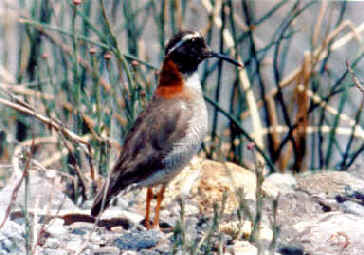
Above & below: Diademed Plovers
during FONT tours in Chile
(photo above by BJ Rose)
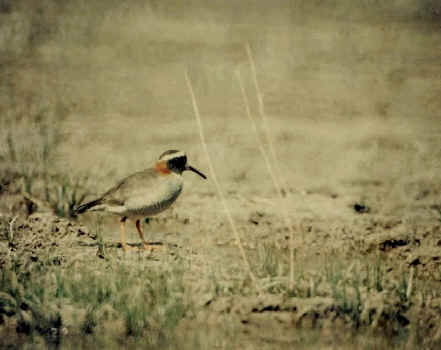
Above & below: These
Diademed Plovers were
photographed during the FONT Chile Tours
in November 1990 (above), during the first of all FONT tours,
and as recently as in November 2009 (below).
The top photo of the three here was taken sometime in between,
(photo above by Alan Brady; photo below by Robert Hinz)
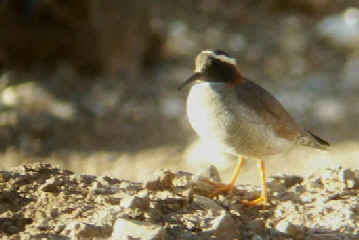
62 RED KNOT
______ in Patagonia: Argentina, Chile
Calidris canutus
The inclusion of the Red Knot in this list is in relation to one
particular subspecies:
Calidris canutus rufa, the subspecies that breeds in far-northern
Canada and migrates to southern South America, as far south as Tierra del Fuego.
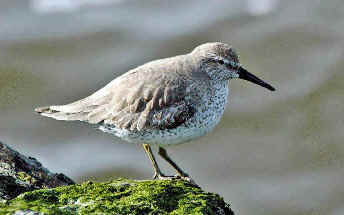
A Red Knot in non-breeding
plumage
(photo by Howard Eskin)
The following text is from a special feature, as it was given on the "Birdline"
by Armas Hill
on the internet on June 13, 2005,
relating to RED KNOTS and other shorebirds that have staged annually over the
years,
in the late-spring, along the shores of the Delaware Bay in the USA.
Those KNOTS having flown there from Patagonia in South America.
Some of this feature was on the Birdline on the Radio on June 15 & 22, 2005.
Other text of this Birdline feature, given on the internet only, on June 22, is
also given here.
The feature relates to the connection in the birdlife throughout the Americas,
in places that
geographically are so far apart, with the KNOTS staging in eastern North America
before
nesting in Arctic Canada and then migrating to far-southern South America, year
after year.
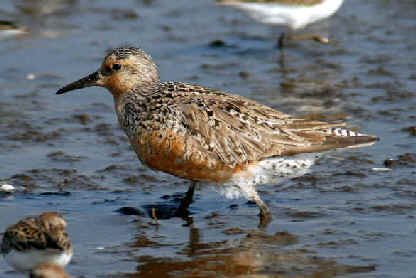
A Red Knot in breeding plumage
(Photo by Howard Eskin)
RED KNOTS IN AMERICA IN PERIL
in Chile, Argentina, Delaware & New Jersey, and northern Canada
written by Armas Hill
Thousands of miles away from us here in North America, in far-southern South
America, there's a ferry that carries mostly trucks and a few cars
across the Strait of Magellan.
Even though it's at the eastern end of the strait, not far from the Atlantic,
it's in Chile.
In the water, by the boat, there are Commerson's Dolphins, with their
beautiful black and white pattern.
Also in the water, Magellanic Penguins fish.
In the sky, King Cormorants fly, with black-and-white coloration, like
the dolphins and the penguins.
In the air, above the feeding penguins, there are South American
Terns emitting their raucous calls as they
fly about.
Southern Giant Petrels fly by, ready to scavenge.
At a distance, over the sea, Black-browed Albatrosses continuously glide up and
down in arcs.
Also at a distance, but on a beach, there's a flock of shorebirds that only
recently arrived from somewhere else.
It's November. When it's spring, going into summer, at the Strait of
Magellan, back in the
Northern Hemisphere, from where the shorebirds came, it's fall, going into
winter.
All of the other wildlife just mentioned resides year-round in the Southern
Hemisphere.
But the shorebirds have gone from one summer to another to feed on
the beach there, in the intertidal zone of mollusks and crustaceans.
The shorebirds in a flock are Red Knots, the subspecies
Calidris canutus rufa,
that inhabits the Americas.
In that area of Chile, just referred to, nearly no people live. There are no
towns or cities. Even the ferry operators live in small settlements some
distance away. There's no pollution, and virtually no noise, other than what is
natural..
If one were to walk along the coast with the knots, just a short distance from
the sound of the ferry, only surf and natural sounds such as the raucous calls
of the terns would be heard.
Also in southern Argentina, but a thousand miles to the north, along the
Atlantic coast, there are long and clean beaches that extend for miles. Again, many of
those miles are without people, pollution, and unnatural noise.
Along some stretches of that coast, in Patagonia, there are seals and
sea lions, Killer Whales and dolphins, in and beyond the surf, and Southern
Right Whales in
some of the bays.
Various gulls and terns are throughout.
Also along parts of that Argentine coast, there can be thousands of Manx
Shearwaters (in November, having come from the European side of the North
Atlantic), and groups of big, colorful Burrowing Parrots that reside in the sandy
coastal bluffs by the ocean.
Along the sandy beaches below the bluffs and beyond for many miles, there are,
again, flocks of shorebirds. Again, during the Austral spring and summer, they are
Red Knots. Birds in these flocks until recently numbered in the thousands.
Inland, just a few kilometers, from one of those coastal locations in Argentina,
there's a large farm property with many acres of natural shrubby vegetation.
There's a lot of (natural) sound there, as the terrain is filled with mockingbirds of two species that are very vocal.
There are a number of interesting landbirds, including one endemic to Argentina,
the Carbonated Finch, a sparkling bird! (Yes, that's a pun.)
What has also been there is another songster, the Yellow Cardinal. (Instead of
being red & black as is the Cardinal in North America, it's yellow and
black.)
To see a photo of the Yellow Cardinal, go to number #12 in this list.
The farm just described is owned by a man named Senor (or Mr.) Manana.
Yes, it's true, "Senor Manana".
As the Yellow Cardinal that's been on his property is prized as a cage bird, due
to its beautiful song and striking appearance, people sometimes come there to
capture it.
With too much of that unfortunate activity recently, that species has now been
classified by Birdlife International as "endangered", the second level
after "critically threatened".
With too much of that activity, that
species won't have too many more "mananas" (or "tomorrows",
in Spanish).
Down the highway a bit from Sr. Manana's farm, there's a hotel, where young
ornithologists have periodically stayed, the last few years, from October
onwards, as they have been banding the Red Knots on the nearby beaches.
During our tours, we have stayed at that same hotel.
In conversations there at the hotel, even just a decade ago, it was not
anticipated that those shorebirds there would be declining as drastically as the
pretty songster, the Yellow Cardinal, down the road.
About a week before I wrote this essay (back on Sunday, June 5, in 2005), in
Delaware USA, people with the Division of Fish & Wildlife of that state,
were continuing their efforts to monitor the shorebirds along the Delaware
Bayshore, as they had been doing every year since 1997.
Along the coast that day, near South Bowers Beach, there was a lingering group
of shorebirds that contained about 600 Knots, 600 Sanderlings, 1,500
Ruddy Turnstones, and 1,500 Semipalmated Sandpipers.
During 6 hours with the birds that day, the researchers found about 50 marked,
or banded, birds.
About half of them were Red Knots, marked during the previous
three years (2002-2004), with some lime flags.
At least 1 was flagged in Chile
(maybe by the beach by the Strait of Magellan), and 3 of the Knots were flagged
in Argentina (probably on the Atlantic beach in northern Patagonia, near Senor
Manana's farm).
Every year, the Red Knots, Calidris canutus rufa, make a nearly
18,000-mile
round-trip journey between Argentina & Chile and far-northern North America
(Arctic Canada), where they nest.
The first stage of their northbound migration includes, as it has for a long,
long time, a 3 to 4 thousand mile flight (usually non-stop) to the
Delaware Bay
shores.
Upon their arrival, the hungry birds must feed on the Horseshoe Crab eggs, laid on the beach at that time of year, in the
late-spring.
That feeding
is necessary for the birds to continue, with the needed energy, on the rest of
their migration, with yet another long flight to northern Canada.
The Red Knot
depends almost exclusively on the Horseshoe Crab eggs to successfully complete
the migration to their nesting grounds.
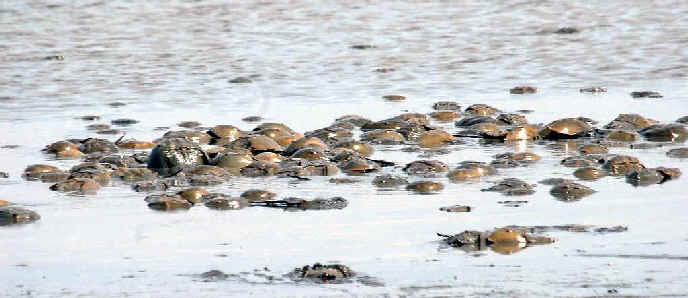
Above: a mass of Horseshoe Crabs on a tidal shoreline of eastern North America
Below: a single Horseshoe Crab
(upper photo by
Howard Eskin; lower photo by Rise Hill)
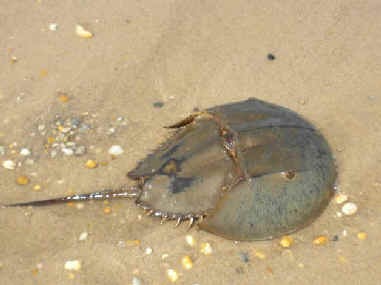
The Red Knot population, visiting the Delaware Bay shores in the spring, has
numbered more than 150,000 birds.
Recent surveys, however, have shown that number has dropped dramatically to an
estimated 15,000 birds.
In the last 10 years, according to those studies, this Red Knot population has
declined more than 90%.
Surveys in the Delaware Bay area have fluctuated from about 16,000
Red Knots in 2003 down
to about 13,000 in 2004, then up to about 15,000 in
2005.
Added to this is a sad statistic relating to a recent survey in South America.
In 2005, there, only 17,600 knots were counted, a
decline of 40% from the
previous year.
The Red Knot, in the Americas, may now be said to be the most endangered
shorebird population in the world.
Not just the Red Knot, but 5 other species of shorebirds, are dependent upon the
horseshoe crab eggs along the Delaware Bayshore.
In 2005, according to New Jersey's chief endangered species biologist, surveys
of Horseshoe Crab eggs in New Jersey and Delaware indicated, where as
normally
4,000 eggs are laid per meter, the count was about 1,500. That was not good.
Also, in both New Jersey and Delaware, Horseshoe Crab eggs have been harvested,
with annual harvests being about 150,000.
Thus, in certain years, there have been 300,000 less Horseshoe Crabs, depleting
further the food supply needed by the Red Knot and 5 other species of
shorebirds.
A grouping of 11 organizations have joined together to petition the state
governments of New Jersey and Delaware, with a proposal of 4 specific actions
urgently needed to save the situation, due to all of the evidence that there is of
a "death spiral" for the Red Knot.
The 11 organizations are these:
the American Bird Conservancy, the American Littoral
Society, Citizens Campaign for the Environment, Defenders of Wildlife, the
Delaware Audubon Society, the Delaware Riverkeeper, the National Audubon
Society, the New Jersey Environmental Federation, the NJ Public Interest
Research Group, and the Sierra Club.
The 4 actions:
1) institution of a moratorium on Horseshoe Crab harvesting
2) support efforts in surrounding states to enact such a moratorium and measures
to conserve the shared resource
3) support efforts to federally list the Red Knot, Calidris canutus rufa, under
the Endangered Species Act
4) continue bay-wide efforts to reduce human harassment (of all kinds) of
foraging shorebirds.
Truly time is of the essence for helping the Red Knot, to be as it has been in the
Americas. Without such help, again, there simply may not be that many more
"mananas" for the bird, on the beaches not that from from
Senor Manana's farm.
Now, some more information regarding the history of
shorebirds including the Red Knot along the Delaware
Bay, as given by Armas Hill in the Birdline Feature on the internet, on
Birdline Delaware and the Philadelphia Birdline, on June 22, 2005, as
a continuation of the June 13 feature that preceded it:
It was noted that in
2004, survey-work indicated that the late-spring staging population of the Red
Knot along the
Delaware Bayshore was about 13,000 birds.
And it was noted that was considerably less than what the
population was a couple decades previously.
It was also noted last time that the Red Knot is just one of about a half-dozen
species of shorebirds that stage in the late-spring along the shores of the
Delaware Bay.
Over 90 per cent of the shorebirds that flock in the late-spring along the
Delaware Bay are of 4 species: Semipalmated Sandpiper, Ruddy
Turnstone, Red Knot, and Sanderling.
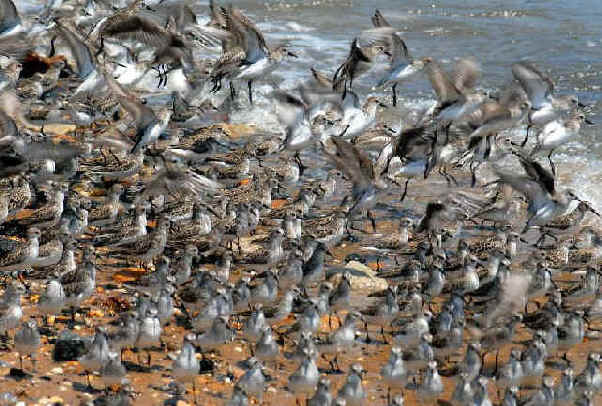
On May 29, 2006, this flock of Semipalmated Sandpipers
was along the Delaware Bay at Port Mahon, in Delaware.
(Photograph by Howard Eskin)
Smaller numbers of
Short-billed Dowitchers and Dunlin also occur. That makes 6 species of
shorebirds in addition to Laughing Gulls that feed on the Horseshoe
Crab eggs on the beach. Also, about a dozen
other species of shorebirds occur in the area in the spring.
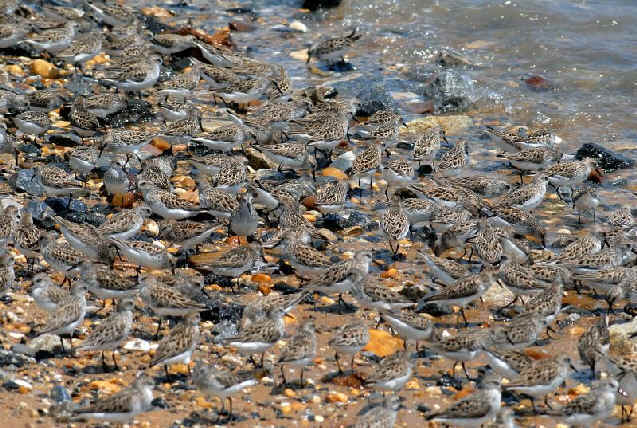
Semipalmated Sandpipers
(photo by Howard Eskin)
During the years 1982 to 1995,
in the spring, as many as 272,000 Semipalmated Sandpipers were counted on
both shores (Delaware & New Jersey)
of the Delaware Bay.
The high-day of the year, during that period, averaged 112,000.
After 1988, no day-count exceeded 100,000.
These Semipalmated Sandpipers non-stop 2,700 miles from Surinam, in northern
South America, to the Delaware Bay shores. It is an astonishing journey, really,
for those small birds - smaller yet, weighing less than an ounce when they
arrive.
Once by the Bay, they fuel up on the Horseshoe Crab eggs, as they must, to
continue their migration north. This feeding is also necessary, in the same way,
for the same reason, for the other shorebird species about to mentioned.
During the years just referred to, the annual high-day for Ruddy Turnstones
averaged 70,000.
It was as high as 108,000 in 1989.
The Ruddy Turnstones by the Delaware Bay in May probably represent about
three-quarters of the eastern North American population. These birds winter from
South Carolina south to southern South America, along the Atlantic Coast.
With their sturdy bills, Turnstones not only turn stones, they also dig holes in
the sand to expose more Horseshoe Crab eggs. They thus provide what could be
called a foraging service for other shorebirds.
Regarding Red Knots, most of which migrate to the Delaware Bay from as far south
as Tierra del Fuego (in far-southern South America), nearly as many as 100,000
have been counted during one day (96,000). The average high-day for the species
during the survey period (from 1982 to 1995) was 48,000.
Many of the Sanderlings that stage by the Delaware Bay in May come mostly from
wintering-quarters in Brazil. But some also come from the sandy coasts of Peru
and Chile on the Pacific side of South America. A few winter further north, in
for example, Florida.
The maximum high-count for Sanderlings by the Delaware Bay in May started to
decline in the early 1980's. From 56,000 in 1982, it dropped steadily to a level
of 10,000 in 1993, 1994, & 1995.
That decline followed a substantial decrease of perhaps 80 per cent of the
Sanderling population along the East Coast of the USA from 1972 to 1982,
continuing the downward spiral.
Generally, over the years, in the Delaware Bay area, Sanderlings have been more
to the south, closer to the mouth of the Bay.
To continue our look back at shorebirds by the Delaware Bay, and to continue our
effort to get a good perspective of what has been, we'll go now to the writings,
done back in 1937, by one of the foremost ornithologists of that region in those
days, Witmer Stone. His work, published that year, was entitled
"Bird
Studies at Old Cape May".
What Witmer Stone did NOT refer to in that work were large
flocks of shorebirds
as just mentioned, being by the Delaware Bay on the New Jersey side, at places such as
Reed's Beach, where since then such large flocks have been.
One could assume, wrongly perhaps, that those flocks of Knots and
Turnstones and
the like were there, but that Mr. Stone did not know about them. However, when
reading through his book, it is apparent that ornithologists of that day did know
what was about, and so another assumption can be made that such large flocks
simply weren't there.
What Witmer Stone did refer to was the rampant shooting of shorebirds that
formerly took place along that part of the coast of eastern North America.
The Red Knot, he said, was known to the gunners as the "Robin
Snipe"
or "Red-breasted Snipe".
It, along with the Dowitcher (in those days a single species), before the
shooting was abolished, were among the most desirable of the shorebirds from the
gunner's standpoint, as they both decoyed easily. Thus, they both, according to
Stone, "nearly approached extermination".
The accounts in Stone's 1937 book refer to Knots occurring in southern New
Jersey, in the early part of the 20th Century, in small groups of 150 or so, or
in "low numbers" of less than a hundred. He relates that a gunner, for
instance, in late-May 1907, shot 29 of them in Cape May County.
Something very important in relation to shorebirds happened in 1913. That year,
the Federal Migratory Bird Law went into effect and the season was CLOSED on ALL
shorebirds except the Woodcock, Black-bellied Plover, Golden Plover, and
Snipe
(known then as the Wilson's Snipe, as it is now known again today), and the two
species of Yellowlegs.
In 1926, the two species of Plovers were put on the protected list, and in
1927
the Yellowlegs followed them.
The season on Woodcock and Snipe, the only two "shorebirds" remaining
on the game list, was subsequently reduced to one month with a bag limit.
Populations of the shorebirds of coastal New Jersey were monitored in the late
1920's and early 1930's.
During that period, let's pick a year - 1931.
For that year, here's a ranking of SHOREBIRD SPECIES in New Jersey, during
their
northward spring migration in May, listing the most common first, and then those
less so in descending order:
1 - Semipalmated Sandpiper
2 - Ruddy Turnstone
3 - Black-bellied Plover
4 - Semipalmated Plover
5 - Greater Yellowlegs
6 - Sanderling
7 - Least Sandpiper
8 - Dowitcher (nearly all Short-billed of course, but in those days as
noted, it was a single species)
9 - Whimbrel (was then called the Hudsonian Curlew)
10 - RED KNOT
11 - Dunlin (was called then the Red-backed Sandpiper)
12 - Lesser Yellowlegs
13 - Western Sandpiper
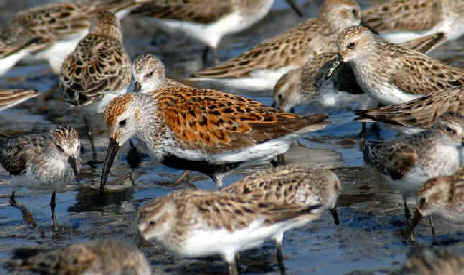
A Dunlin surrounded by Semipalmated Sandpipers.
The Dunlin has been called the "Red-backed Sandpiper".
(photo by Howard Eskin)
The following shorebirds, overall during the period 1929-1934, were classified
in New Jersey as "abundant" or "very common":
Semipalmated Sandpiper, Sedmipalmated Plover, Sanderling, Dowitcher, Least
Sandpiper, Greater Yellowlwgs.
Notice, now, that the Red Knot was in the second category, those classified as
"common".
In that grouping, there were these species:
Black-bellied Plover, Killdeer, Ruddy Turnstone, Dunlin, Red Knot, Western
Sandpiper, Lesser Yellowlegs (less
common during the northbound migration than during the southbound), Whimbrel,
Pectoral Sandpiper, Spotted Sandpiper.
The author Peter Matthiessen wrote a fine book about shorebirds, published in
1967, and entitled "The Wind Birds".
In it, he also alluded to the widespread shooting of shorebirds that was
referred to by Witmer Stone. That shooting was very prevalent in the late
1800's. It also continued in the early 1900's, even as some species started to
show significant declines.
Matthiessen wrote that "under the circumstances, it's a wonder that any
shorebirds survived into the 20th Century". They were shot in numbers, and
they were trapped.
There was even a practice of "fire-lightning", that
was commonly done, for example on Long Island NY, when after dark resting flocks
of shorebirds, blinded by a bright beam, stood by while men stepped out from
punts and wrung their necks.
Among the gunners of that era, Knots and Dowitchers, as noted earlier, were
favorites. So were Golden Plovers and Eskimo Curlews, not only because of their
fine taste and great numbers (yes, even so for the Curlew), but also because
they were unsuspicious to a fault. The Eskimo Curlew would circle back over the
guns, calling out to its fallen companions. That was a habit shared by the Dunlin,
Dowitcher, and other species. The Dunlin was called "the
simpleton" by Long Island hunters, reflecting the low esteem in which its
brain was held.
After the legal protection for shorebirds came to be, as noted in 1913,
for a
number of species, through the 20th Century, things improved. For the Eskimo
Curlew, it was too late.
Yes, shorebirds that at one time existed by the thousands, can in time
disappear.
The following is a passage from Alexander Wilson's "American
Ornithology", written in the early 19th Century:
"Everyone who has been on the shore, on a day gleaming and cloudy, may have
seen masses of these birds at a distance, appearing like a dark and swiftly
moving cloud, suddenly vanishing, but then in a second, appearing at some
distance, glowing with a silvery light almost too intense to gaze upon. These
are the consequences of the simultaneous motions of the flock, at once changing
their position, showing the dark gray of their backs, or the pure white of their
underparts."
With these words, Alexander Wilson was writing about the Knot (in its winter
plumage). In his day, the bird was called the "Ash-colored Sandpiper".
The scientific name, "Calidris canutus", refers to King Canute, who
loved to eat it (the species does have a European population).
4 books, written over the years, have already been noted in this essay.
Another one is: "The Flight of the Red Knot" by Brian Harrington
and Charles Flowers, published in 1996.
If you can get it, it's interesting, and
with good background about the Knot.
FONT (Focus On Nature Tours) goes to southern South America, to Argentina &
Chile. Although people don't normally travel to the opposite end of the world to
see birds that migrate from their homelands, it is a nice experience to see the
places where these birds go. And it's fascinating in a way to share the long
migration of the KNOTS and other SHOREBIRDS.
Places to be visited in southern South America referred to in this bulletin
include:
PATAGONIAN ARGENTINA: the coastal region with the miles of beaches, and Senor
Manana's farm (with the YELLOW CARDINAL), north of the Valdez Peninsula, and
TIERRA DEL FUEGO, in far-southern ARGENTINA.
During FONT Argentina tours, in addition to the Yellow Cardinal and
Red Knot,
other birds and wildlife in the preceding text have been seen, including:
Magellanic Penguin (including a colony with a million), Southern Giant
Petrel, Black-browed Albatross, Manx Shearwater, South American Tern,
Burrowing Parrot, Carbonated Finch, and Southern Right Whale, Killer
Whale (or Orca), and seals and sea-lions..
And that's just some of the nature that we've observed!
Magellanic Penguin and Black-browed Albatross are elsewhere
in this list, as is the Yellow Cardinal with a photograph.
Click here for: UPCOMING
FONT TOURS IN ARGENTINA
63 HUDSONIAN GODWIT ______ in
Patagonia: Argentina, Chile
Limosa haemastica
No longer classified by Birdlife International as a
"near-threatened species", the Hudsonian Godwit continues in this
listing, however, as it was so categorized for a number of years, and the
species does have an interesting story.
The Hudsonian Godwit is an extraordinary migratory
species, undertaking two long journeys each year, between northern Canada &
Alaska where it nests during the summer in the Northern Hemisphere, and
southern South America, in Argentina & Chile, where it spends the summer
in the Southern Hemisphere.
The Hudsonian Godwit is highly gregarious, often in great flocks of only
its own kind. Such flocks are in Patagonia during the austral summer,
from September to March, on northern Tierra del Fuego in Argentina, and
on Chiloe Island in Chile, where the birds feed on mudflats, searching
especially for small molluscs and crustaceans.
Over two-thirds of the entire population of Hudsonian Godwits
spends the austral summer on northern Tierra del Fuego, with thousands of
them along the shores of Bahia San Sebastion.
About one-quarter of the global population of Hudsonian Godwits
spend the austral summer on Chiloe Island where they are on mudflats that
are expansive due to a significant difference between high and low tides.
The large flocks of Hudsonian Godwits on Chiloe Island, that have been seen
during FONT Chile Tours there, are generally composed of just the godwits.
Hundreds, up to thousands of them, can be seen at one place, at one time.
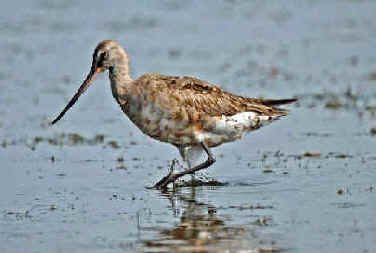
Above : a single Hudsonian Godwit
(photo by Howard Eskin)
Below: Hudsonian Godwits at a mudflat on Chiloe Island,
photographed during a FONT tour in Chile
(photo by Frank Stermitz)

64 FUEGIAN SNIPE ______ in Patagonia: Argentina
Gallinago stricklandii
65 IMPERIAL SNIPE ______ in
the Andes: Ecuador
Gallinago imperialis
66 COLOMBIAN SCREECH OWL
______
in the Andes, Ecuador
Megascops colombianus
During the April 2013 FONT tour in Ecuador, a Colombian Screech Owl was
seen.
67 BLACK-THIGHED PUFFLEG ______ in the Andes: Ecuador
Eriocnemis derbyi
68 HOARY PUFFLEG ______ in
the Andes: Ecuador
Haplophaedia lugens
69 TOUCAN BARBET ______
in the Andes: Ecuador
Semnornis ramphastinus
No longer in the Family CAPITONIDAE with the other American barbets,
the Toucan Barbet is now placed in a family by itself, SEMNORNITHIDAE,
being closely related to both toucans and barbets.
During the April 2013 FONT tour in Ecuador, the Toucan Barbet was nicely
seen.
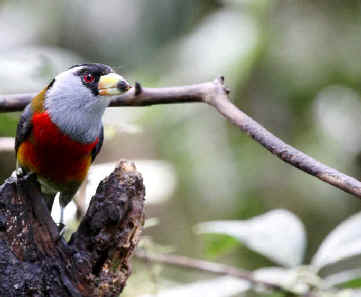
A Toucan Barbet during the FONT Ecuador Tour in April
2013
(photo by Marie Gardner)
70 PLATE-BILLED MOUNTAIN-TOUCAN
______ in the Andes: Ecuador
Andigena laminirostris
The Plate-billed Mountain-Toucan has been seen nicely during FONT Ecuador
Tours on the western side of the Andes.
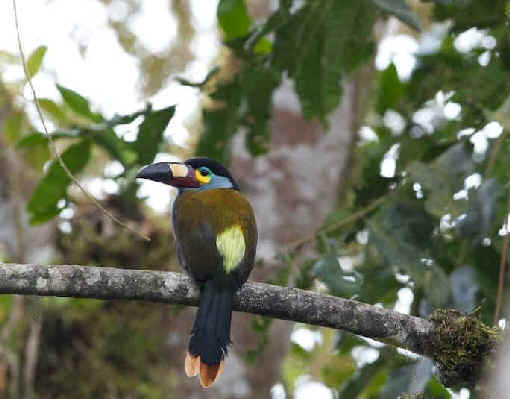
Plate-billed Mountain-Toucan
(photo by Mark Felber in April 2013
at the Bellevista Reserve, in Ecuador)
71 GRAY-BREASTED
MOUNTAIN-TOUCAN ______ in the
Andes: Ecuador
Andigena hypoglauca
The Gray-breasted Mountain-Toucan has been seen nicely during FONT
Ecuador Tours on the eastern side of the Andes.
72 YELLOW-HEADED MANAKIN ______
in the Andes: Ecuador
Xenopipo flavicapilla
73 OLIVE-SIDED FLYCATCHER ______
in the Andes: Ecuador, Venezuela, Colombia
Contopus cooperi
74 ORANGE-BANDED FLYCATCHER
______ in the Andes: Ecuador
Nephelomyias (formerly Myiophobus) lintoni
75 OCHRE-BREASTED ANTPITTA
______ in the Andes: Ecuador
Grallaricula flavirostris
The Ochre-breasted Antpitta was seen well during the April 2013 FONT
Ecuador Tour on the western side of the Andes.

An Ochre-breasted Antpitta during the FONT tour in
Ecuador in April 2013.
(photo by Marie Gardner)
76 PERUVIAN ANTPITTA ______
in
the Andes: Ecuador
Grallaricula peruviana
77 CRESCENT-FACED ANTPITTA
______ in
the Andes: Ecuador
Grallaricula lineifrons
78 MAQUIS (or IQUICO) CANASTERO ______
in the Andes: Argentina, Bolivia
Asthenes heterura
79 EQUATORIAL GRAYTAIL ______ in
the Andes: Ecuador
Xenerpestes singularis
80 STAR-CHESTED (or FULVOUS-DOTTED)
TREERUNNER ______ in the Andes:
Ecuador
Margrornis stellatus
81 GREATER SCYTHEBILL ______ in
the Andes: Ecuador
Drymotoxeres pucherani
82 BEAUTIFUL JAY ______ in
the Andes: Ecuador
Cyanolyca pulchra
83 BAR-WINGED WOOD WREN
______ in the Andes: Peru, Ecuador
Henicorhina leucoptera
84 GOLDEN-WINGED WARBLER ______
in the Andes: Venezuela, Ecuador
Vermivora chrysoptera
85 GRAY-THROATED
WARBLER
______ in the
Andes: Venezuela
Basileuteus cinereicollis
86 GIANT
CONEBILL ______ in the Andes:
Ecuador,
Chile
Oreomanes fraseri
87 BLACK-AND-WHITE TANAGER ______
in the Andes: Peru, Ecuador
Conothraupis speculigera
88 PURPLISH-MANTLED TANAGER ______ in
the Andes: Ecuador
Tridosornis porphyrocephalus
89 MASKED SALTATOR ______ in
the Andes: Ecuador
Saltator cinctus
![]()
A NEW SPECIES described
recently, in 2013:
90 PINCOYA STORM
PETREL ______ in Patagonia: Chile, Argentina
Oceanites pincoyae
Oceannites pincoyae has been described
too recently (in January 2013) for assessment, as of now, by Birdlife
International as to its status as a threatened, or near-threatened
species.
But it does have a restricted geographic range and its total population has been
estimated as being only from 5,000 to 10,000 individuals, thus categorizing it
in some way as a "rare species".
THE FOLLOWING RELATES TO THE SPECIES HAVING BEEN SEEN
DURING A FONT TOUR
BEFORE IT WAS DESCRIBED,
ALONG WITH TEXT AS TO HOW THE NEW SPECIES CAME TO BE,
information compiled & written by Armas Hill, the leader of the FONT Chile
Tour
during which the PINCOYA STORM PETREL was seen.

During a ferry-boat crossing
(in the photo above) to Chiloe
Island, on December 1, 2009,
as part of the FONT Nov/Dec '09 Tour in Chile, some
storm-petrels were noticed that appeared "different".
They had more white than would normally be seen on the Wilson's Storm Petrel,
thus appearing to have more contrast, with white upper wingbars, a seemingly
pale underwing, and even, most oddly, apparently white bellies.
What we did not know at the time was that earlier that same year, another group
of birders (from Ireland: Seamus Enright, Michael O'Keefe &
friends), in waters in much that same area, also observed such similar
storm-petrels.
Since then, this news:
In February 2011, during a five-person multi-national expedition led by British
seabird expert Peter Harrison, 12 of the "mystery storm petrels" were
captured at sea near Puerto Montt, Chile. By so doing, that team has been able
to confirm the existence of a new species.
According to Harrison, "These birds appear to be a new species, as they are
so different from any other storm petrels we know." There are 22
known species of storm petrels worldwide.
The following narrative, from the blog "Birding Abroad", relates more
about the news:
Recent sightings of unidentified storm petrels in Seno
Reloncavi, south of Puerto Montt, Chile, have been confirmed as a new
species,
as recently published in "Dutch Birding" (O'Keefe et al 2010).
A team of biologists led (as noted above) by British seabird expert Peter
Harrison, has just completed an expedition to that area of Chile.
The expedition followed Harrison's earlier examination of two skins of an Oceanites
sp. housed in the Museo Argentino de Ciencias
Naturales in Buenos Aires, Argentina.
Those two skins had been described by Pearman as the first Argentine records of
the Elliot's Storm Petrel, Oceanites gracilis
galapogoensis (Pearman 2000).
On examining the specimens, Harrison concluded that the two originally collected
at El Bolson, Rio Negro province, Argentina, in February 1972 and November 1983
represented a hitherto undescribed taxon and were probably the mysterious
unidentified storm petrels of Puerto Montt, Chile, which is just 70 kilometers
west of El Bolson.
Two members of the team of biologists, Chris Gaskin and
Karen Baird from New Zealand, were both involved in at-sea captures and searches
for the breeding location of the recently rediscovered New Zealand Storm
Petrel (Gaskin & Baird 2005, Stephenson et al. 2008).
The Chilean expedition spent 4 days at sea in the Seno Reloncavi area, where
they made use of chum or berley (fish scraps) to attract seabirds within range
of the specially designed net-guns. These were critical to the success of the
expedition and were developed in New Zealand for the capture of the New
Zealand Storm Petrel.
Over the four days at sea, over 1,500 sightings of the new
Oceanites species were
recorded.
To enable the scientific description of the new species, the 12 birds (as
noted above) were captured for the collection of biometric data and samples
of blood and feathers taken for genetic work.
The new species would appear to be most closely related to the Elliot's
Storm Petrel, Oceanites gracilis.
But in appearance it is intermediate between the Wilson's Storm Petrel
and
the New Zealand Storm Petrel.
It shows a distinctive pale upper wing crescent and a prominent white bar across
the underwing coverts.
Unlike typical Elliot's Storm Petrels, the white
feathering in the ventral area is much more subdued and restricted and does not
extend toward the upper breast. The wing measurements are also very different
and show no overlap with the mainland Elliot's Storm Petrel.
The expedition team estimates a population of 5,000 to
10,000 birds in the Seno Reloncavi area, where the new taxon appears to be the
most abundant of the resident seabirds, with flocks of several hundred
individuals at chum slicks.
The timing of the expedition appears to have coincided with the fledging period
as juveniles were among the captured birds, suggesting that breeding occurs in
the Seno Reloncavi area, possibly beginning in November.
A wider search of the Seno Relanocavi and Golfo de Ancud area needs to be
undertaken in both summer and winter.
Further analysis of feather and blood samples is expected to confirm this
discovery and a full scientific publication is in preparation by the expedition
team.
That analysis has since been done, and in January
2013, the new species was described, the Pincoya
Storm Petrel, Oceaniites
pincoyae, published that month in "The
Auk", the publication of the AOU, the American
Ornithologists Union. A color illustration of the new storm petrel is on the
cover of that issue.
The name "Pincoya" commemorates a female water spirit in Chilote
mythology, a mixture of myths, legends, and beliefs of the people who live on
the island of Chiloe in southern Chile.
That mythology reflects the importance of the sea in the life of the Chilotes
(those who live on Chiloe Island).
Chilote mythology is based on a mixture of the indigenous religions of the
Chonos and Huiliches who have long been inhabitants on Chiloe, together with
legends and superstitions brought by the Spanish when they arrived there in
1567, thus beginning a fusion of elements that would form a separate mythology.
That Chilote mythology flourished, due to the isolation and remoteness of the
island culture from the more "mainstream" society of the Spanish and
other Europeans elsewhere in Chile,
In that mythology, the "Pincoya" is a female "water spirit"
of the Chilotan Seas. said to have long blond hair, and to be of incomparable
beauty, to be cheerful and sensual, and to rise from the depths of the sea.
Naked and pure, she personifies the fertility of marine species. Through her
ritual dance she provides the residents of Chiloe with either an abundance or
deficiency of fish and seafood.
If she performs her dance facing the sea, it means that the shore will have an
abundance of fish.
When she dances facing the mountains, with her back to the sea, seafood will be
scarce.
Chilote mythology is appreciative of the "Pincoya" who is believed to
be good, beautiful, and humanitarian.
According to legend, Pincoya is the daughter of Millalobo, who was the
"king of the sea"' in Chilote mythology and a human named Huenchula.
Over the years, there have been a number of Focus On
Nature Tours to the island of Chiloe, where both the nature and the culture have
been enjoyed and appreciated.
On the island during those FONT tours, a wonderful assortment of birds and
mammals have been seen.
Birds have included colonies of penguins and other seabirds, rafts of
swans and
other waterbirds, large flocks of godwits, as well as parakeets, hummingbirds,
tapaculos, and Magellanic Woodpeckers and other birds of the fascinating
Nothofogus forest.
Mammals have included the rare Marine Otter, or Chungungo, and the diminutive
deer called the Pudu.
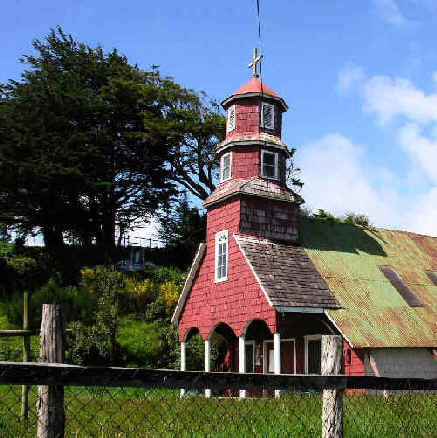
Two
photographs taken during
the FONT tour on Chiloe Island in November 2011
(photos by Frank Stermitz)
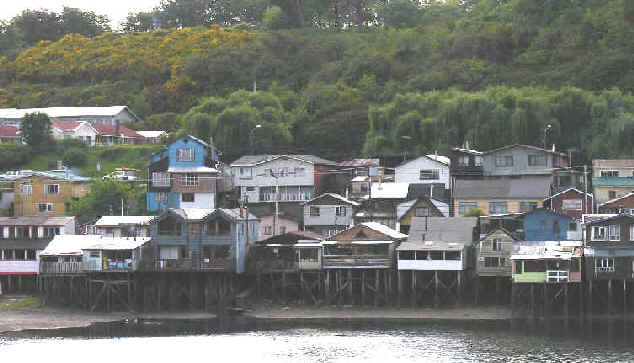
Beneath the photos below is what was written in the FONT website in 2010, relating to the "Dutch Birding" article mentioned above.
These photos were taken in nearly the same Chilean waters
a few months before our Nov/Dec '09 FONT tour,
taken in February 2009 by Michael O'Keeffe
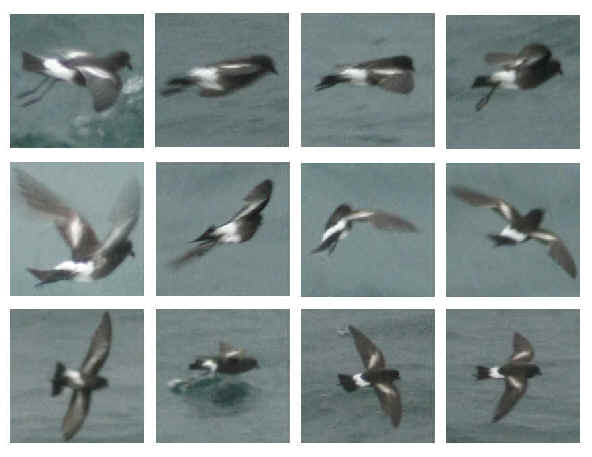
This "mystery
storm-petrel" was seen during the FONT Chile tour
on December 1, 2009 from the ferry to Chiloe Island.
It has since been described, in January 2013,
as a new species, the Pincoya Storm Petrel.
What follows now,
regarding these storm-petrels in southern Chilean waters, is from a paper that
was authored in 2009, by Jim Dowdall, Seamus Enright, Kieran Fahy, Jeff
Gilligan, Gerard Lillie, and Michael O'Keeffe, for DUTCH BIRDING (published in
2010):
The most
striking feature of the birds was the extent of white in the plumage underneath,
suggesting initially one of the Fregetta storm-petrels.
However, other features seemed to rule out that option, including the extent of
dark on the flanks and the prominent carpal bar.
The birds appeared to have characteristics making them Oceanites
storm-petrels, similar but perhaps slightly
stockier of the chilensis Wilson's
Storm Petrel. But the whitish upper-wing and under-wing panels appeared more
striking than chilensis. The
white on the rump appeared to wrap completely around the vent/lower belly,
although from photos it is hard to rule out the presence of perhaps some dark
feathering on the sides and the center of the vent.
Below, some answers to a couple questions
that have been asked during the years, from 2009 to 2013:
Why have these birds apparently gone
undocumented until now?
Other
visiting birders, in recent years, in the coastal waters south of Puerto Montt,
and from the ferry crossing to/from Chiloe Island, have noted similar birds.
For example, Peter Harrison first encountered them while working onboard the
tour vessel M.V. Linblad Explorer, out of Puerto Montt in 1983 and 1984.
Harrison also saw the birds again in later years. On two occasions, he remarked
that he "was lucky enough to have one land on the deck during the night and
was able to give them careful scrutiny. Using his only reference (Murphy, 1936),
and based on measurements he obtained, Harrison concluded the birds to be
chilensis.
The enigmatic chilensis race of the
Wilson's Storm Petrel has had a checkered history.
Robert Cushman Murphy in the "Oceanic Birds of South America" (1936)
described how the taxa Oceanites oceanicus
chilensis was inadvertently first published nomen
nudum by W.B. Alexander in "Birds of the Oceans" (1928).
The taxa was later described in detail by Murphy (1936) and referred to as the "Fuegian
Petrel", a new subspecies of the Wilson's Storm Petrel.
Subsequent to that, and for reasons not quite understood, the taxa was
"dropped" as a race of the Wilson's. Until very recently, only
two races of Wilson's Storm Petrels, oceanicus
and exasperates, were recognized in
the literature, including by Harrison (1983, and in subsequent editions).
Interestingly, in relation to the Wilson's Storm Petrel, Harrison has
noted that "Cape Horn birds have pale vents", again apparently
relating to chilensis, noting also some pale
mottling on the lower belly.
Onley and Scofield (2007) have recently re-established chilensis
as a race of the Wilson's Storm Petrel.
So, a conclusion could be that the storm-petrels, with the white on their
vents/bellies in the Chilean waters south of Puerto Montt were undocumented in
part due to the lack of understanding of the form chilensis
also occurring in those waters, and probably most importantly, they were
undocumented because simply not many people were aware of them.
The storm petrels, with the white apparently more extensive than
chilensis, have been observed south of Puerto Montt, in the
channel north of Chiloe Island (where they were seen during the 2009 FONT
tour), and also in the Gulf of Penas, approximately 500 kilometers south of
Puerto Montt. It is therefore suggested that these birds are relatively
localized and sedentary,
Could these birds really
be a new species?
The most conservative explanation was that
they would simply be a previously un-described plumage or morph of one of the
species already known from the region.
The combination of plumage features of the new storm petrel perhaps most
closely matches the Elliot's Storm Petrel. But generally that species
generally has much more white on the upper belly and generally more dark
feathering on the vent, creating a distinctive divide between the white belly
and the rump.
Also, the waters south of Puerto Montt seem surely to be too far removed, so far
south of the range of the Elliot's, which is a warm-water species, and
thus not apt to occur to cold southern Chilean waters.
Very interestingly in relation to the new storm petrel, repeating
here what has already been noted earlier:
in 2000 a note was published regarding two specimens of storm petrels
that were taken (back in 1972 & 1983) from El Bolson, in the province of Rio
Negro, in southern (Patagonian) Argentina.
They were assigned to the northerly race of the Elliot's Storm Petrel, galapogoensis.
They erroneously represented the first (and the only) records of Elliot's
Storm Petrel for Argentina (where they would have been assumed to have been
from the South Atlantic.)
The wing measurements of the new "white-bellied" storm petrels
from south of Puerto Montt in Chile (now, the Pincoya Storm Petrel, Oceanites
pincoyae) indicate those birds to be larger than
gracilis Elliot's, and within the range of chilensis
or galapogoensis (with however, as already
noted, their plumage features not matching either of those taxa).
The El Bolson (Argentina) birds are only marginally longer winged than the
Puerto Montt Oceanites pincoyae
birds, as studied by Harrison in the hand.
It has been determined that the two El Bolson specimens are examples of the
Oceanites pincoyae storm petrels of the waters
south of Puerto Montt, and not the Elliot's.
Returning again to the chilensis race of the
Wilson's Storm Petrel, some observers have been of the opinion that it
may in actuality be closer to the Elliot's than to the Wilson's.
With the new "white bellied" storm petrels (Oceanites
pincoyae) from south of Puerto Montt having now received analysis, it
may be worthwhile to re-think, and thus give further study, the entire storm-petrel
taxa in the region of southern Chile.
It is hard not to draw certain parallels between this story of storm petrels
in southern Chile and that of the New Zealand Storm Petrel,
Oceanites maorianus, that was only recently,
in 2003, found to be alive and well.
Indeed, the "white-bellied" Puerto Montt/Chiloe Island birds, now
Oceanites pincoyae, share a startling similarity with that rare
species that lives on the far-opposite side of the South Pacific Ocean.